Childhood 1912-1930
A village childhood Li Qun’s roots trace back to a quaint mountain village, an enclave characterised by a mere six
With the demise of the “Gang of Four” a wave of joy swept across China. Li Qun, like countless others, found himself advancing into a new chapter in the aftermath of the storm, standing on the edge of a “sinking boat” and in front of an “ailing tree” metaphor for the arts that was almost nonexistent during the ‘”Gang of Four” era, but now with tremendous possibilities.
In early 1977, after returning to Taiyuan from his hometown, Li Qun, despite being sixty-five, continued to serve as the Vice Chairman of the Provincial Federation of Literary and Art Circles and a member of the Standing Committee of the Provincial CPPCC. Subsequently, he assumed the presidency of the Shanxi Painting Academy and the honorary presidency of the Shanxi Academy of Fine Arts. His active involvement continued, with his participation in the 4th National Congress of Literary and Art Circles in 1979, where he was elected as a member of the All-China Federation of Literary and Art Circles and an executive director at the third member representative conference of the National Artists Association.
In 1980, he played a pivotal role in the establishment of the National Woodcuts and Printmakers Association, assuming the positions of vice chairman and editor-in-chief of Woodcuts and Printmaking magazine. Even at the age of 83 in 1995, he was honoured as the elected honorary chairman.
Post-1977, Li Qun was frequently invited to give lectures, conduct woodcuts and printmaking training classes, judge art competitions, or simply engage in leisurely pursuits like sightseeing. His travels spanned the northwest, northeast, southwest, Jiangnan, Hainan, and even overseas destinations. He explored places he had long yearned to see as a painter, including Northern Xinjiang, Southern Xinjiang, Daxinganling, Xishuangbanna, “Ends of the World”, Dunhuang, Daqing, Lushan, Terracotta Warriors, Huangguoshu, Hong Kong, Macao, and revisited his alma mater, now the China Academy of Art, formerly National Hangzhou Art College.
Inspired by apricot blossoms in spring rain, river maples, and fishing fires, Li Qun found creative inspiration everywhere he went. He absorbed the vitality of Cangshan Mountain, reflecting on the past and present, refining and summarising, recording and sketching. His life was significantly enriched by the beautiful water of Lingyan, giving rise to numerous works such as “Portrait of Premier Zhou“, “Landscape of the Yangtze River“, “Clear Spring“, “In the Forest“, “Deer Park“, “Goldfish“, “Spring Breeze“, “Tianshan Summer“, “New Trend in Sight“, “Summer Breeze“, “Early Spring“, “Early Spring in the Northland“, “Spring Arrives in Dongting Lake”, “Red Panda“, “Raising Lulu Flowers“, “Lakeside“, “Heilongjiang Autumn“, “Platanus”, “Coveting“, “Early Spring“, “Returning Late on a Spring Evening“, “Farm Guard” and many others, representing the fruitful results of a renewed “spring breeze”.
Moreover, since 1983, Li Qun produced a collection of innovative Chinese flower and bird paintings. His artworks were showcased in solo or group exhibitions across Taiyuan, Beijing, Shenyang, Changchun, Harbin, Guangzhou, Dalian, Qingdao, Yantai, Hong Kong, Taiwan, and his hometown, Lingshi County. They were also featured in exhibitions, selections, collections, acquisitions, and displays in the United Kingdom, the United States, France, Japan, Russia, Denmark, Yugoslavia, Singapore, Australia, Tanzania, Ghana, and other African countries.
In parallel with his artistic achievements, his collection of art essays, “The Fragrance of Plum Blossoms Comes from the Bitter Cold” was officially published, and “Selected Prints of Li Qun” received official publication status. His literary works, including “My Paradise”, “Ma Lanhua”, “The Story of the Wild Girl” and “My Artistic Career” were officially released, with “My Paradise” earning awards in Shanghai and Shanxi. Additionally, his scattered articles in various domestic newspapers and periodicals, along with the influential controversy stemming from “My Dialogue with Writers” highlighted his role as a responsible member of the Chinese Writers Association.
In recognition of his immense contributions, Li Qun was honoured with the “Outstanding Contribution Award for China’s Emerging Woodcuts and Printmaking” from the Chinese Artists Association and the Chinese Woodcuts and Printmakers Association. The Shanxi Provincial Party Committee and the Provincial Government bestowed upon him the title of “People’s Artist” and he was granted a special allowance by the State Council. The Japan-China Art Exchange Center awarded him the “Gold Award for Contribution”.
The era of reform and opening up infused China with vitality, ensuring Li Qun remained robust and full of life well into ancient times. Truly, it can be said that “the dragon still reigns at dusk, and the old trees bloom even more in spring”.
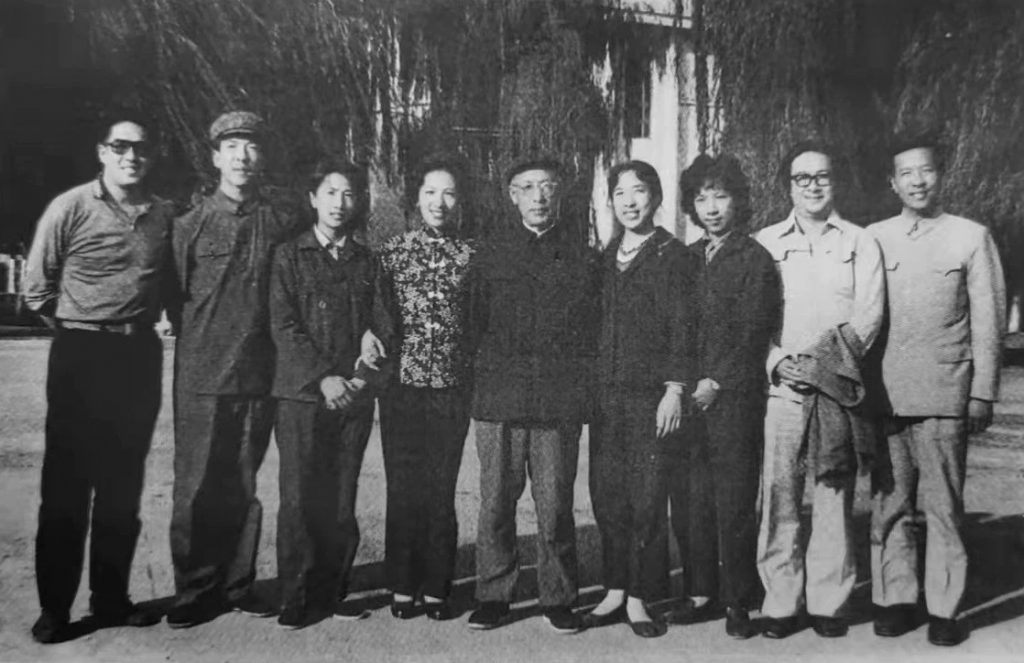
In 1979, Li Qun and his children (from right to left: Hao Tian, Hao Ming, Hao Lan, Hao Hong, Li Qun, Hao Li, Hao Xia, Hao Xiang, Hao Qiang).
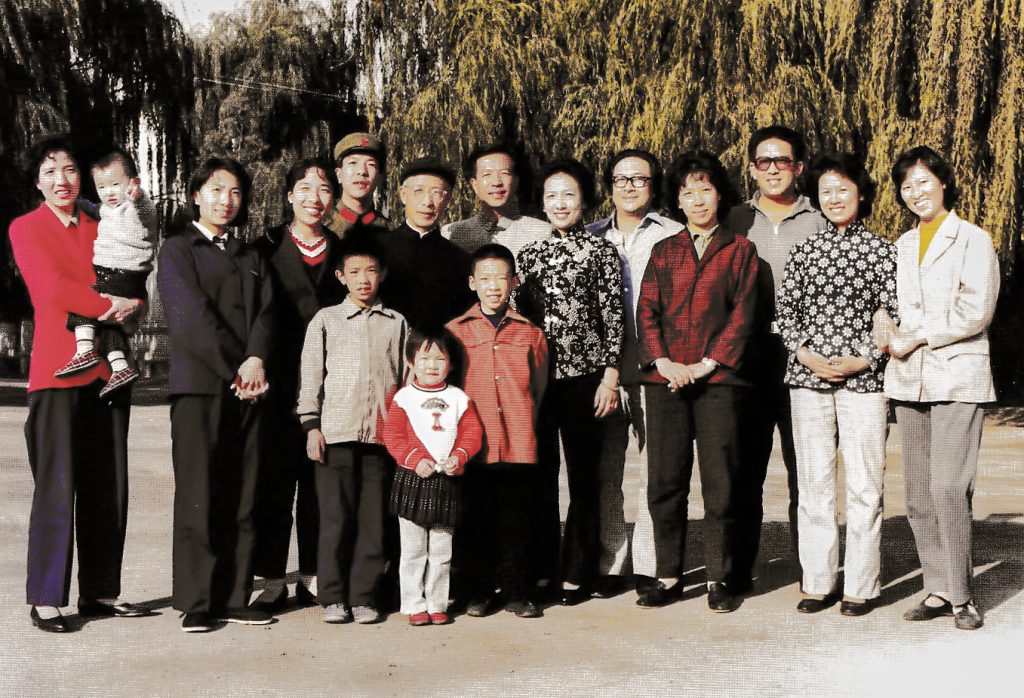
In the aftermath of dismantling the “Gang of Four” Li Qun returned to Taiyuan from his hometown, Hao Jia Zhang Village in Lingshi, in 1977. He assumed the role of Vice Chairman of the Shanxi Federation of Literary and Art Circles and became a member of the Standing Committee of the Provincial Committee of the Chinese People’s Political Consultative Conference.
Initially, Li Qun faced challenges stemming from lingering factional interference from the “Cultural Revolution” hindering the smooth progress of his work. However, the unwavering enthusiasm of his family members consistently provided him with a sense of warmth. A poignant moment was captured in the autumn of 1979 when the entire family posed for a group photograph at the Taiyuan South Cultural Palace.
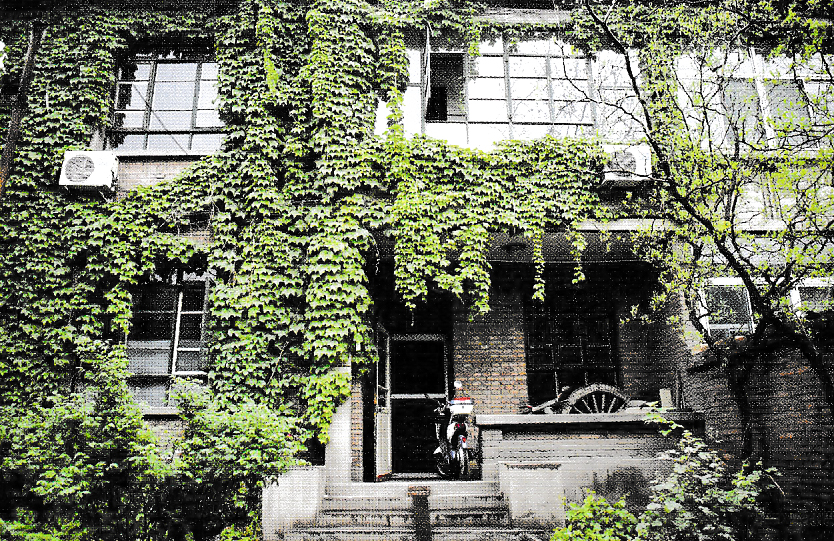
After returning to Taiyuan in 1977, Li Qun initially resided in the South Cultural Palace before relocating to the modest quarters at the Qiaodong Xiugan Office of the Provincial Party Committee. This remained his residence until his move to Beijing in 2001. The image captures Li Qun’s former abode at the Xiu Gansuo residence of the Provincial Party Committee on Jinsong Road, Taiyuan, taken by Zhang Yingkang in 2008.
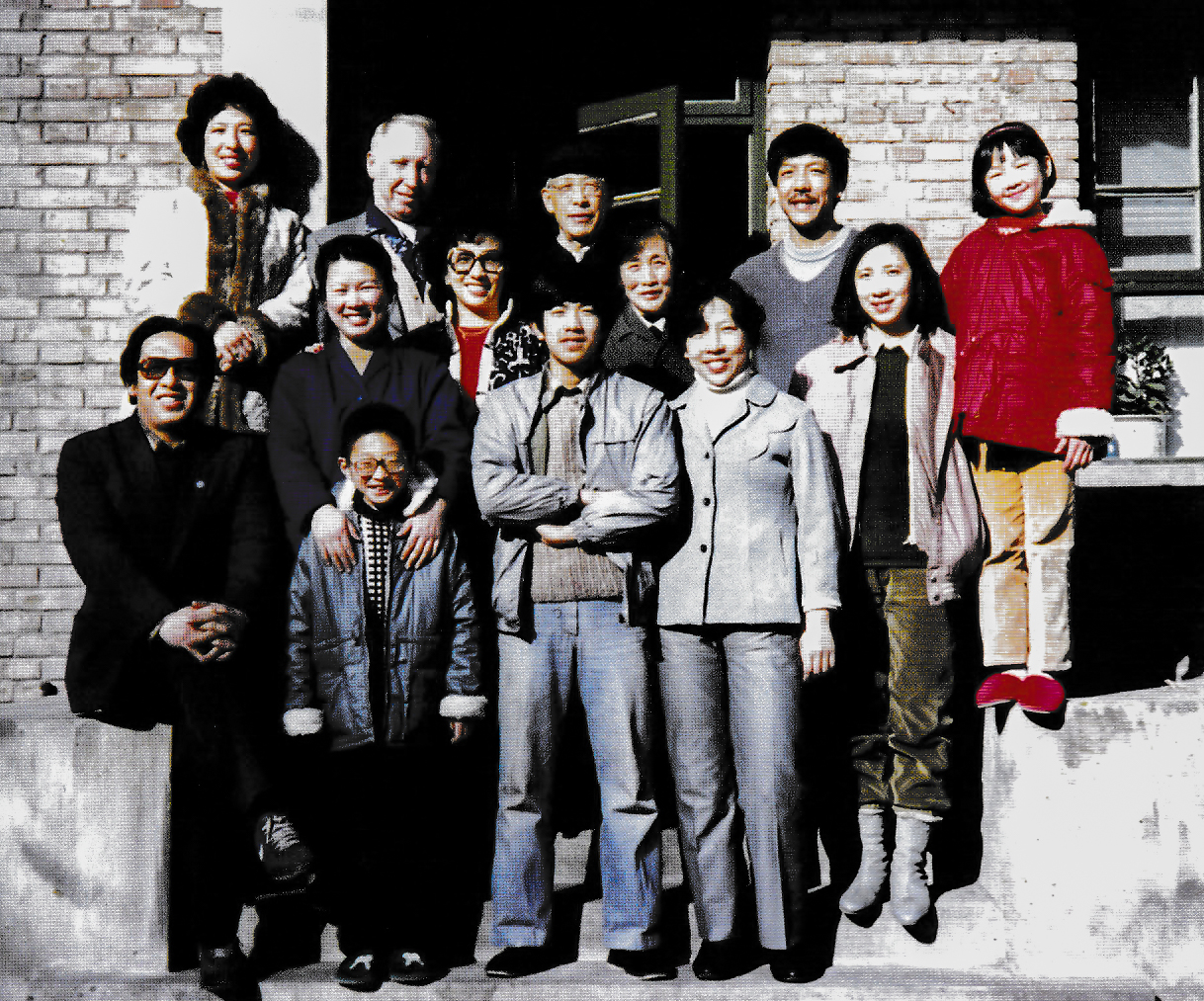
In 1984 This family photograph with New Zealand born grandchildren visiting China for the first time was taken during their stay at the residence of Xiu Gansuo, the Provincial Committee of the Communist Party of China, Jinsong Road, Taiyuan. This period marked the commencement of a new chapter in the opening calendar year.
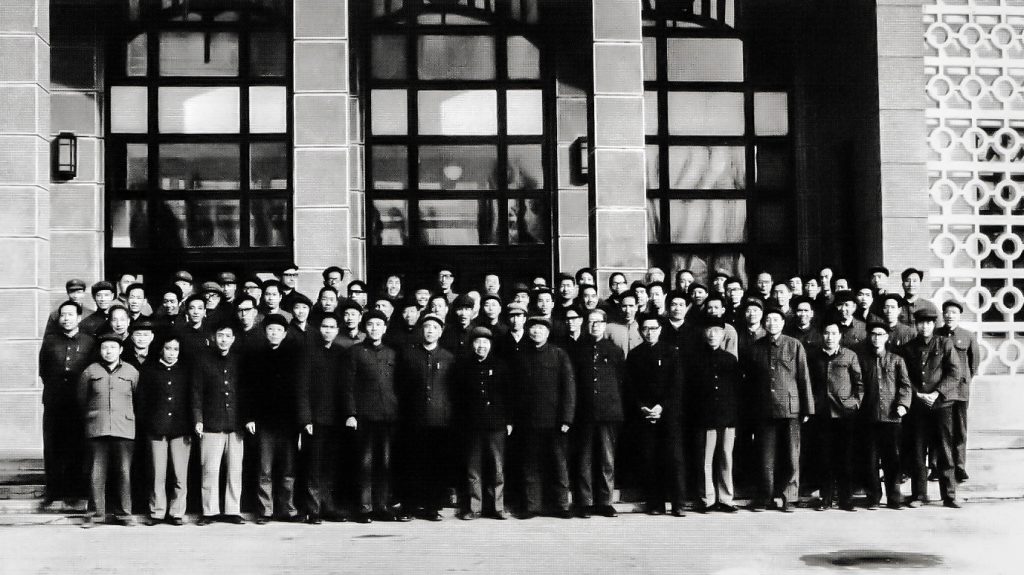
In the inaugural year of the calendar in 1978, Li Qun received an invitation to deliver lectures and conduct woodcuts and printmaking training sessions in Ili, Xinjiang. He also took part in a symposium in Urumqi during a joint exhibition featuring printmaking from the five northwest provinces. A group photo taken after the symposium depicts Li Qun in the fifth position from the right in the front row, with Chang Shuhong in the seventh position from the right in the same row.
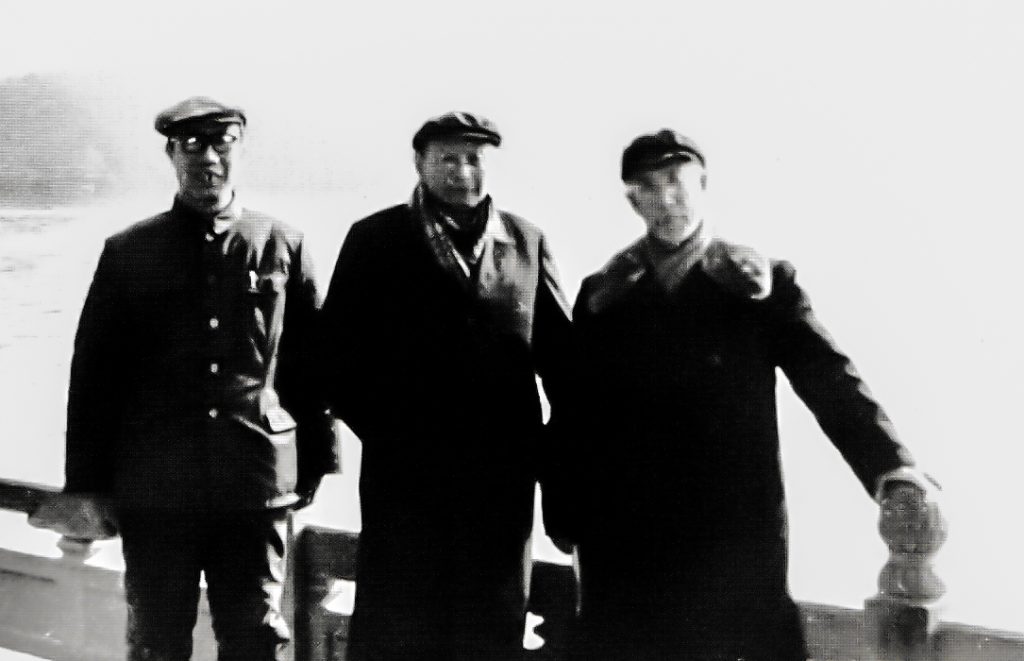
In 1979, Li Qun embarked on a journey to Hangzhou, accompanied by Jiang Feng in the middle.

In the autumn of 1978, Niu Wen (second from the left), Li Qun (fourth from the left), and Song Kejun (first from the left) visited the hometown of Qiu Shaoyun in Tongliang County.
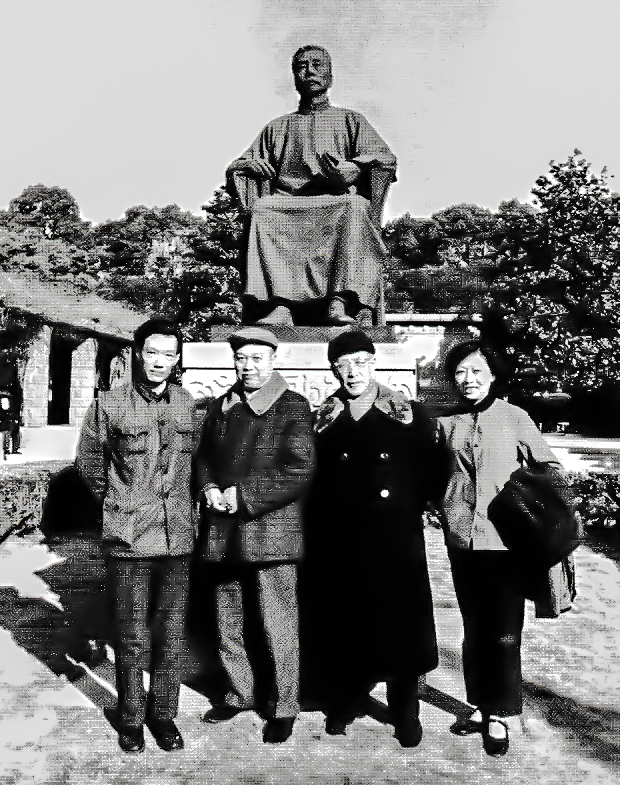
In the inaugural month of the open calendar year, Li Qun saw significant developments in his career. Following the conclusion of the “Cultural Revolution” he achieved notable recognition by being elected as a member of the China Federation of Literary and Art Circles and appointed as an executive director of the Chinese Artists Association at the Fourth National Congress of Literary and Art Circles held in 1979. In the period surrounding these events, Li Qun crafted the black and white woodcuts “Portrait of Premier Zhou” and “Landscape of the Yangtze River“. In December of the same year, he actively participated in the editorial board meeting for “An Anthology of Fifty Years of Emerging Chinese Woodcuts and Printmaking” held in Shanghai. A group photo from the conference captures Li Qun alongside Gu Yuan (second from the left) and other editorial board members.
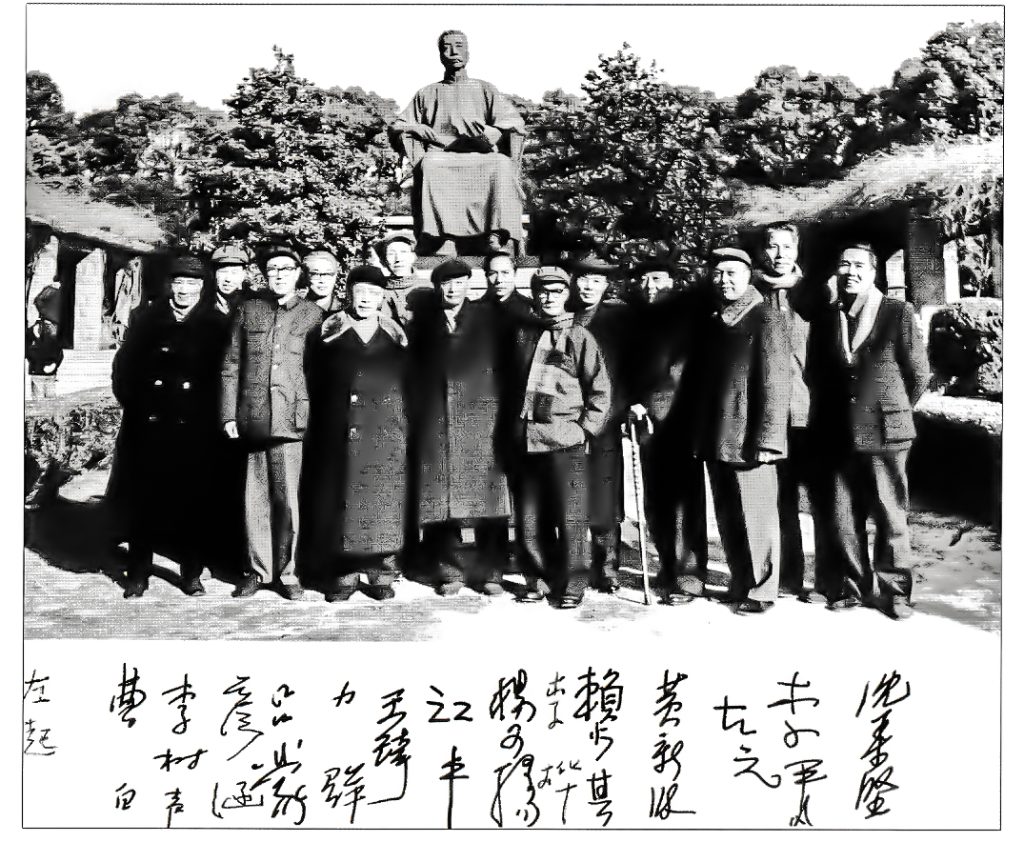
Additionally, Li Qun played a role in the editorial board meeting for “Selected Works of Li Shusheng, Yan Han, Lu Meng, Li Qun, Wang Qi, Jiang Feng, Yang Keyang, and Li Nian”. During this meeting, editorial board members gathered for a group photo and signed their names. Notably, on December 20, 1979, Li Qun took part in the “50th China Emerging Woodcuts and Printmaking Exhibition” in Shanghai.
(Left) In the opening month of the calendar year, Li Qun achieved success in a lecture series. The image above captures Li Qun’s demeanour during his previous speeches, showcasing his engagement in discussions. The lectures delved into the theory and practical aspects of spiritual civilisation and cultural construction, emphasising literary and artistic creation.
(Right) In the image below the Yan’An pagoda, the transformation in the literary and art symposium in Lingshi is portrayed, reflecting Li Qun’s personal reflections on his participation. This narrative is interwoven with intricate details about Jingshi. Around 1980, Li Qun received numerous invitations to deliver talks in various locations, where he shared compelling stories from Yan’an.
In the inaugural year of Wanju’s trendy brand, 1980 marked a significant period for Li Qun, who, at the age of 68, continued his artistic endeavours by creating several impactful black and white woodcuts, including “Clear Spring“, “In the Forest“, “Deer Park“, “Goldfish” as well as coloured woodcuts such as “Spring Breeze“, “Tianshan Summer” and “New Trend in Sight“. Concurrently, he assumed the role of President at the Shanxi Painting Academy. In the accompanying images, Li Qun is seen actively engaged in his creative process. On the left, he carves the colour woodcut “A Trend is in Sight” and on the right, he meticulously drafts the artwork “Clear Spring”.
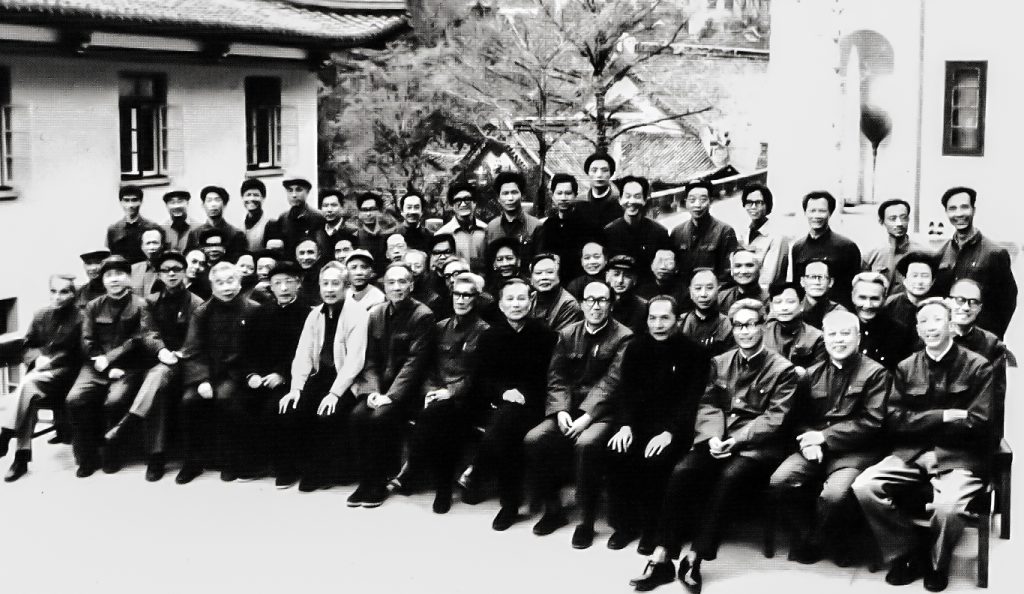
April 19, 1980, witnessed the official establishment of the Chinese Woodcuts and Printmaking Artists Association. The photograph captures participating artists during the conference in Huangshan. Seated in the front row are prominent figures such as Li Shaoyan, Li Qun, Hua Junwu, Cao Bai, Li Hua, Yan Han, and Wang Qi, joined by Gu Yuan, among others.
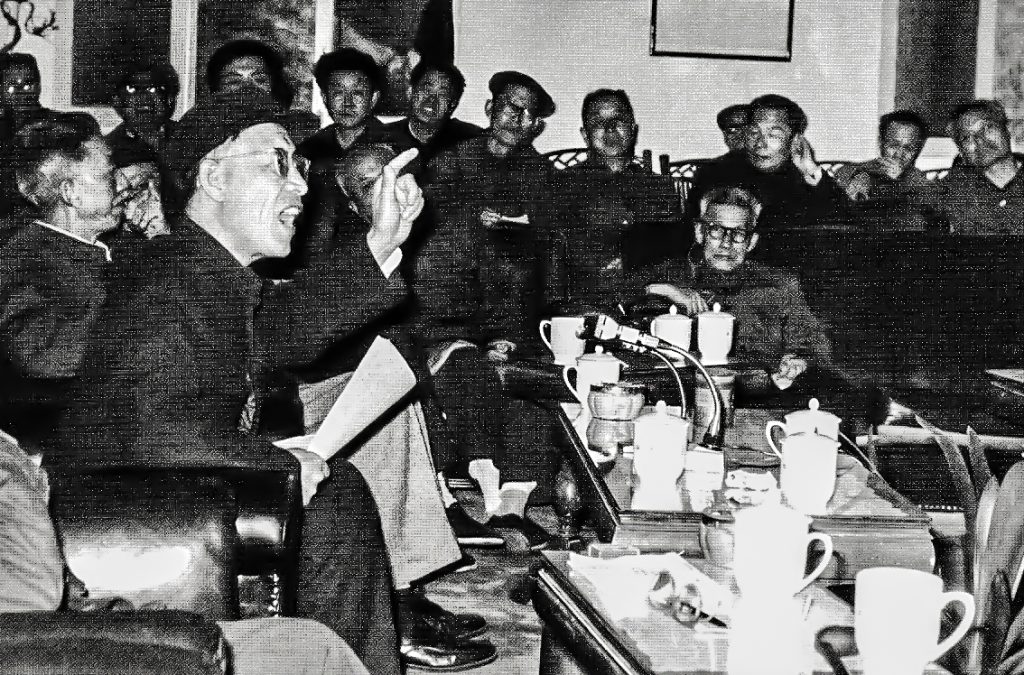
During the inaugural year of the national calendar, Li Qun played a significant role in the establishment of the Chinese Woodcuts and Printmakers Association. At the founding meeting held in Huangshan on April 19, 1980, he was elected as the vice chairman of the Woodcuts and Printmakers Association and assumed the position of editor-in-chief for Printmaking magazine.
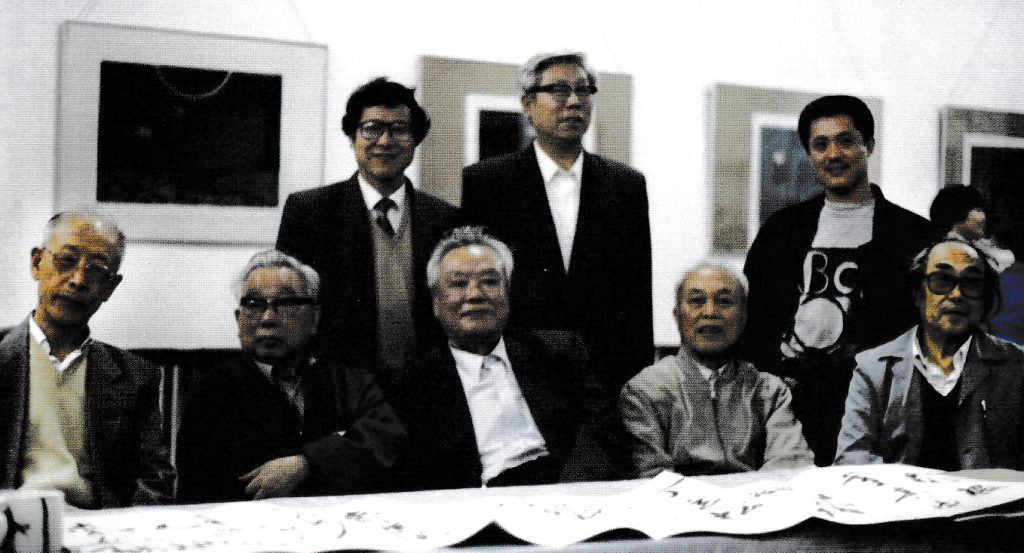
Li Qun alongside fellow woodcuts artists and printmakers attending the conference. In the front row, notable figures include Li Qun, Li Shaoyan, Niu Wen, Gu Yuan, and Yan Han.
During the inaugural year of the national calendar, Li Qun played a significant role in the establishment of the Chinese Woodcuts and Printmakers Association.
At the founding meeting held in Huangshan on April 19, 1980, he was elected as the vice chairman of the Woodcuts and Printmakers Association and assumed the position of editor-in-chief for Printmaking magazine.
(Right) Li Qun alongside fellow printmakers and art scholars attending the conference. In the front row, notable figures include Li Qun, Ai Wei Wei’s father Ai Qing and mother Gao Ying, Li Shaoyan, Niu Wen, Gu Yuan, and Yan Han.
(Left) On May 10, 1980, amidst the “Li Qun Woodcuts Exhibition” at Beihai Park in Beijing, Li Qun shared a memorable moment by posing for a group photo with foreign students visiting from the Woodcuts and Printmaking Department of the Central Academy of Fine Arts.
(Centre) On September 10, 1980, during the showcase of the “Li Qun Woodcuts Exhibition” at Heilongjiang Art Museum, Li Qun seized the opportunity to capture another group photo, this time alongside woodcuts artist and printmaker Du Hongnian and other colleagues.
(Right) Maintaining his artistic discipline, Li Qun continued to carry a sketchbook wherever he went, adhering to his enduring habits. In 1981, during a lecture in Hunan, he visited the zoo and sketched red pandas, showcasing his commitment to capturing interesting moments. Notable works from this period include black and white woodcuts such as “Summer Breeze” and “Early Spring” along with colour woodcuts like “Early Spring in the Northland”, “Spring Arrives at Dongting Lake” and “Red Panda”.
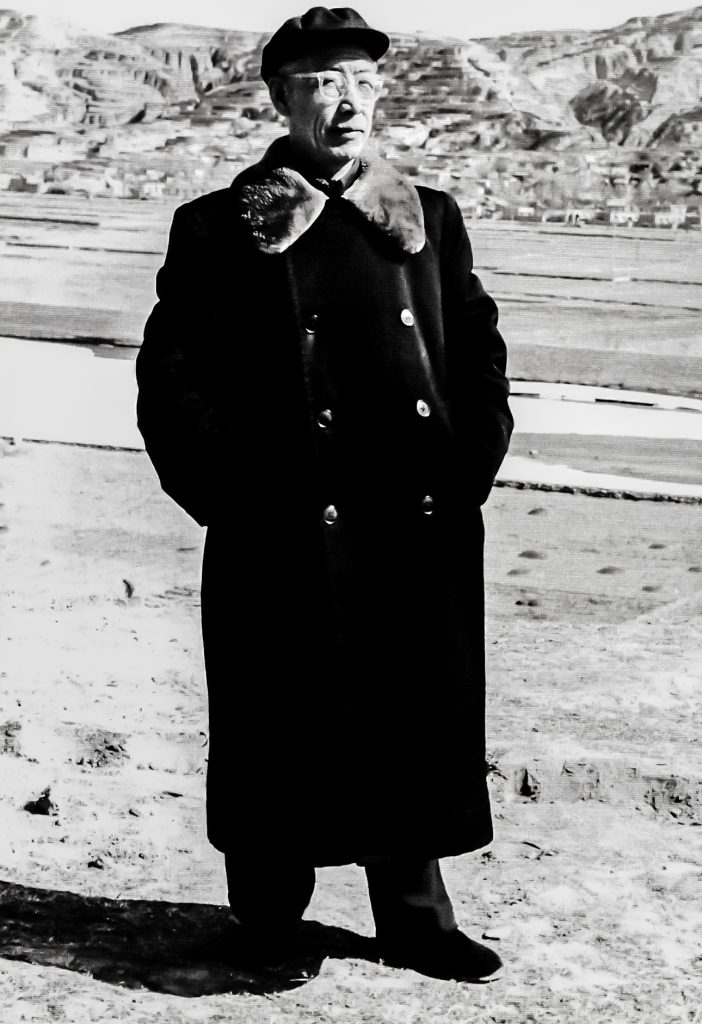
In the pursuit of artistic expression, numerous themes demand portrayal as artworks. Amidst the rugged loess plateau, Li Qun consistently sensed the untold stories waiting to be unveiled. For an extended period, Linxian County remained part of the Shanxi-Sui Border Region, constituting a region of significant interest for Li Qun.
In 1982, amidst the Shanxi Art Work Conference, he captured poignant images in Linxian, marking a chapter in his artistic exploration.
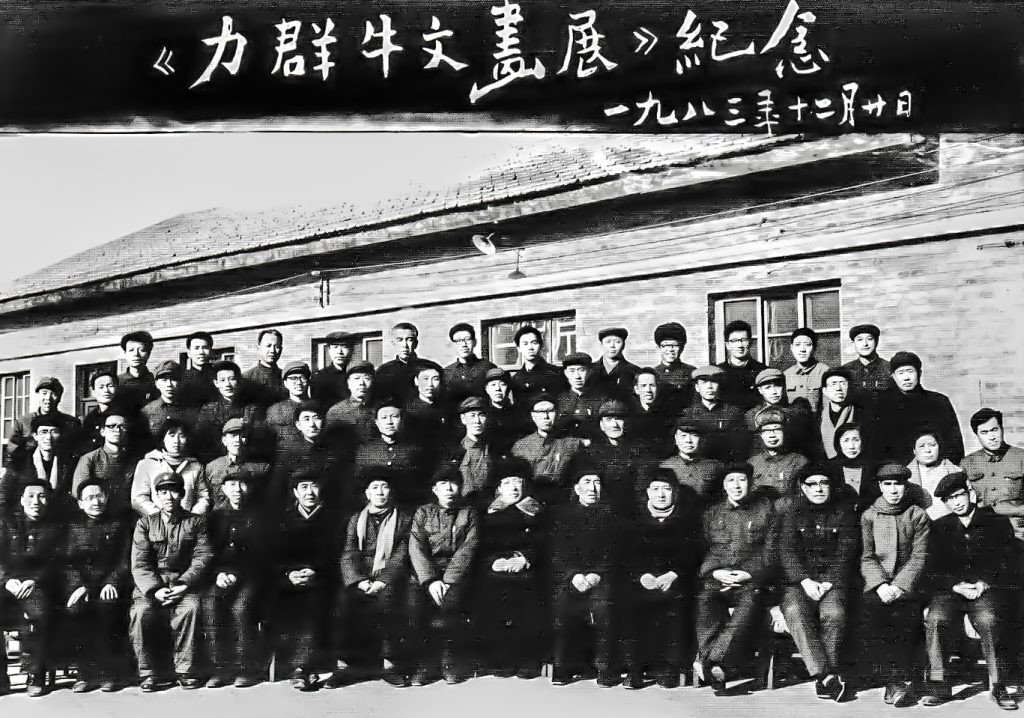
In 1983, Li Qun, surpassing the age of seventy, maintained his unwavering commitment and diligence. During this year, he crafted five woodcut illustrations for Ma Feng’s novel anthology and produced 31 woodcut illustrations for his essay collection, “My Paradise“. Additionally, he created the colour woodcut “Lakeside” and initiated the compilation of his personal collection of art critiques, titled “The Fragrance of Plum Blossoms Comes from the Bitter Cold” and “Selected Prints of Li Qun”.
Towards the end of the year, the “Li Qun and Niu Wen Painting Exhibition” adorned the new structure of the Lingshi County Cultural Center in his hometown. The accompanying image captures him alongside key figures from the province, prefecture, and county, offering a behind-the-scenes glimpse of the exhibition. Noteworthy attendees included Su Guang (fifth from left) and Hu Zheng (sixth from left), as well as the event’s organisers.
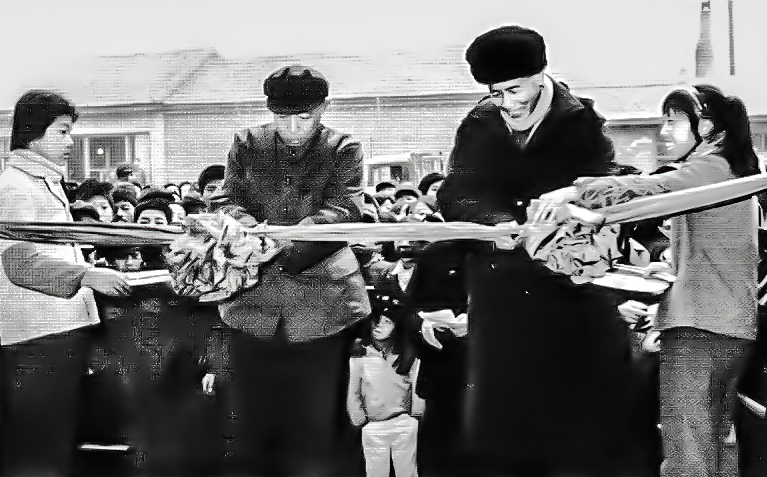
Commemoration of the “Li Qun Niu Art Exhibition”. During the inauguration of the Li Qun and Niu Wen painting exhibition at the new Lingshi Cultural Center building, Su Guang (right), then chairman of the Shanxi Artists Association, and Yang Dachun (left), then secretary of the Lingshi County Party Committee, participated in the ribbon-cutting ceremony. (December 10, 1983)
(Left) One day in 1982, Li Qun was painting in Taiyuan South Cultural Palace. (Centre) Together with painters Yang Lizhou and Wang Yingchun in Jinan (1985). (Right) In 1983, he visited Xiaoxitian in Xi County.
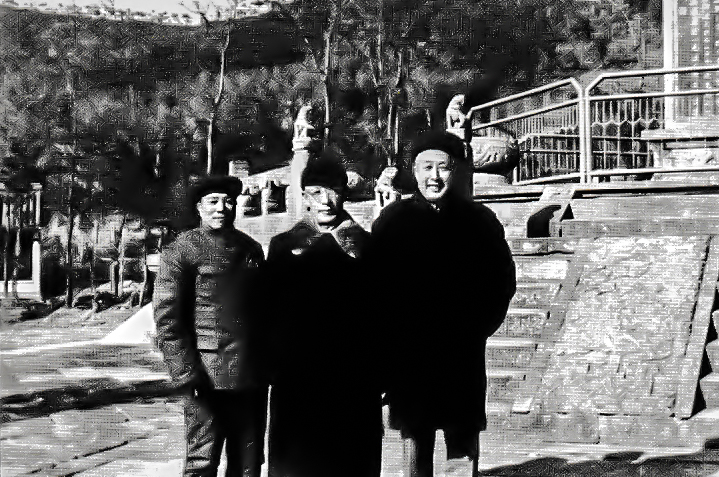
In 1989, Li Qun, accompanied by woodcuts artist printmaker Dong Zhongzhi, embarked on a meaningful pilgrimage to the hometown of Zhao Shuli in Qinshui County, Shanxi Province. The purpose was to pay respects at the tomb of Zhao Shuli, a revered figure in Li Qun’s life. The individual standing on the right in the photograph is Zhao Sanhu, the son of Zhao Shuli.
Reflecting on a separate occasion in 1988, Li Qun exuded vitality on the tennis court in Taiyuan during the sweltering summer, showcasing his enduring energy even at the age of 76.
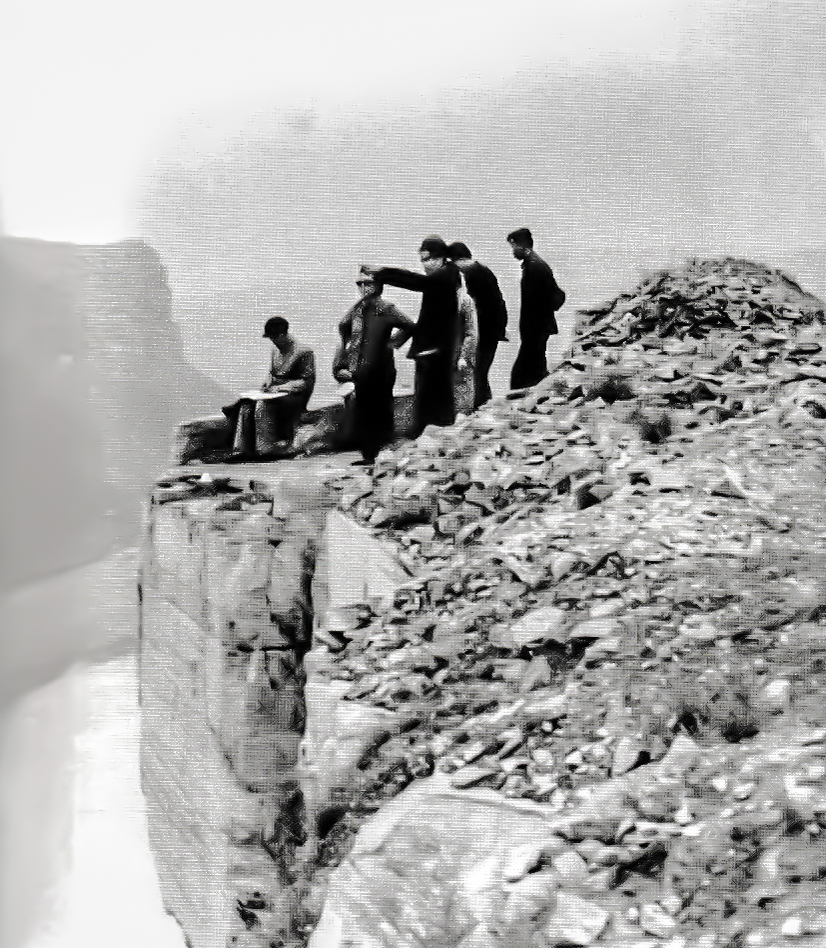
(Left) The Dry Gallery Sketch Art Exhibition marked a significant moment in Li Qun’s artistic journey, capturing the essence of his creative prowess. In attendance were Li Qun, accompanied by the esteemed Cao Bai couple, with Hao Xiang, the fourth son of Li Qun, pictured on the right.
(Centre) He also participated in the opening ceremony of Yan Han’s painting exhibition, sharing the frame with Mrs. Wang Qi, Wang Qi, and Yan Han.
(Right) Additionally, a momentous encounter is documented as Li Qun engages with Liu Xun, the Chairman of the Beijing Artists Association.
(Left) Another notable event was the opening ceremony of Wang Shikuo’s Sketch Art Exhibition, where Li Qun held a prominent position, standing fourth from the right. (Right) Even at the age of 80 in 1991, Li Qun continued to radiate enthusiasm and dedication to his craft. A photo captures his joy during a visit to Yinchuan.
(Left) From December 4th to 10th, 1992, the Shanxi Provincial Art Delegation, under the invitation of Mr. Yoichi Mei from the Japanese Artists Association of Saitama Prefecture, Japan, engaged in a cultural exchange visit. Chinese and Japanese artists participated in extensive artistic dialogues during this period. The attached photograph captures a group moment after one such symposium. Li Qun is positioned second from the right in the front row, beside him is Dong Zhongzhi on the first left, and Yao Tianmu on the first right.
(Right) In commemorating Li Qun’s 60th anniversary of his artistic career and 80th birthday, a celebration was jointly organised by the Lingshi County Party Committee, the county government, and the Shanxi Federation of Literary and Art Circles on December 25, 1991, at the Taiyuan Lingshi Office. Following the event, Li Qun and his wife were photographed with leaders and key individuals from the Lingshi County Party Committee, County Government, and Jinzhong Federation of Literary and Art Circles.
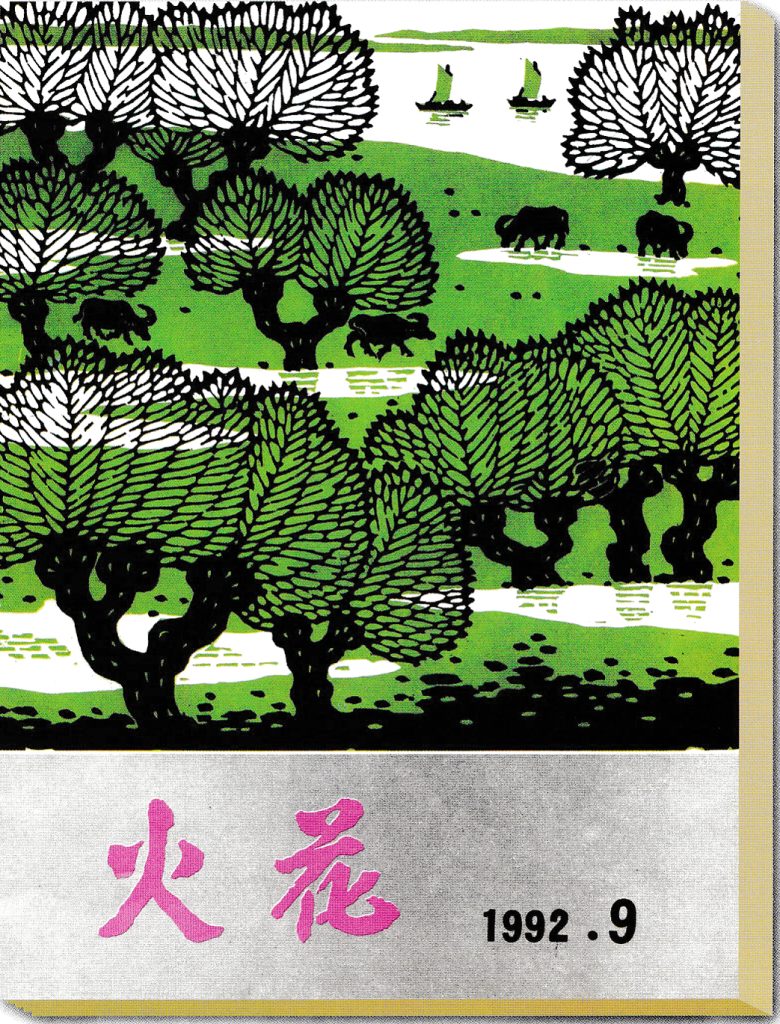
On November 17, 1992, the Chinese Artists Association, in collaboration with the Shanxi Federation of Literary and Art Circles and Shanxi Artists Association, jointly organised the “Academic Symposium on Comrade Li Qun’s 60 Years of Art Creation and 80th Birthday Celebration” in Taiyuan. Preceding this event, the September edition of “Spark” a literary monthly sponsored by the Shanxi Federation of Literary and Art Circles, featured articles by Ai Qing, Hu Zheng, Dong Zhongzhong, and Han Huimin, titled “Commemorating Li Qun’s 60 Years of Artistic Career” as the leading column. The image below displays the cover of this particular issue of “Sparks” featuring Li Qun’s woodcut, “Spring Arrives at Dongting Lake“.
Contents of the September 1992 issue of “Spark”. Poet Ai Qing’s article “Lyric Poems on Woodblocks”. Writer Hu Zheng’s article “The morning glow and sunset are all brilliant”. Woodcuts artist and printmaker Dong Qiqi’s article “An Old Artist’s Road to Success”
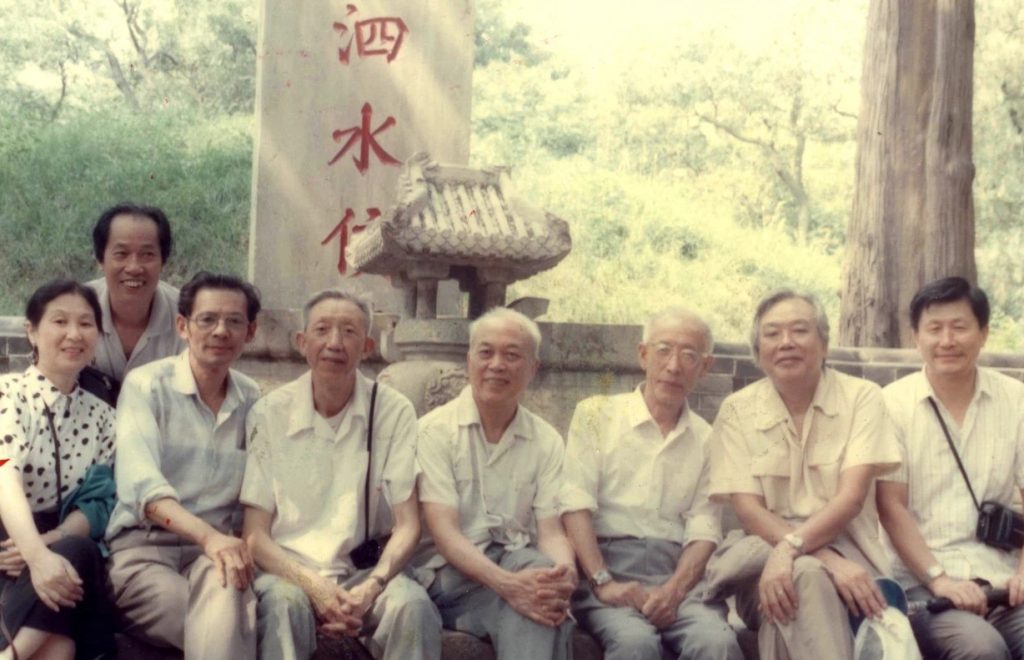
In August 1989, after attending the National Publishers Association Executive Council in Shandong, a photograph was taken in Qufu. From left to right: Jiang Bibo, Xie Niu, Li Xiqin, Wang Qi, Gu Yuan, Li Qun, Niu Wen, and Song Yuanwen.
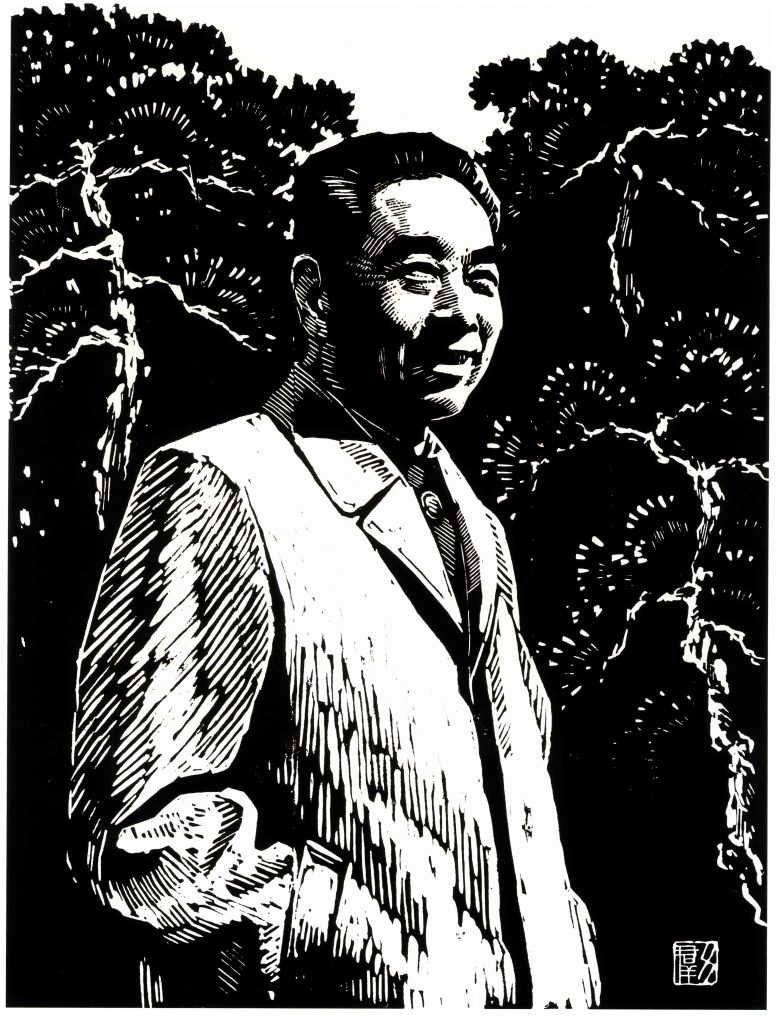
During the period of China’s reform and opening up, a selected work emerged – “Portrait of Premier Zhou” painted in 1979.
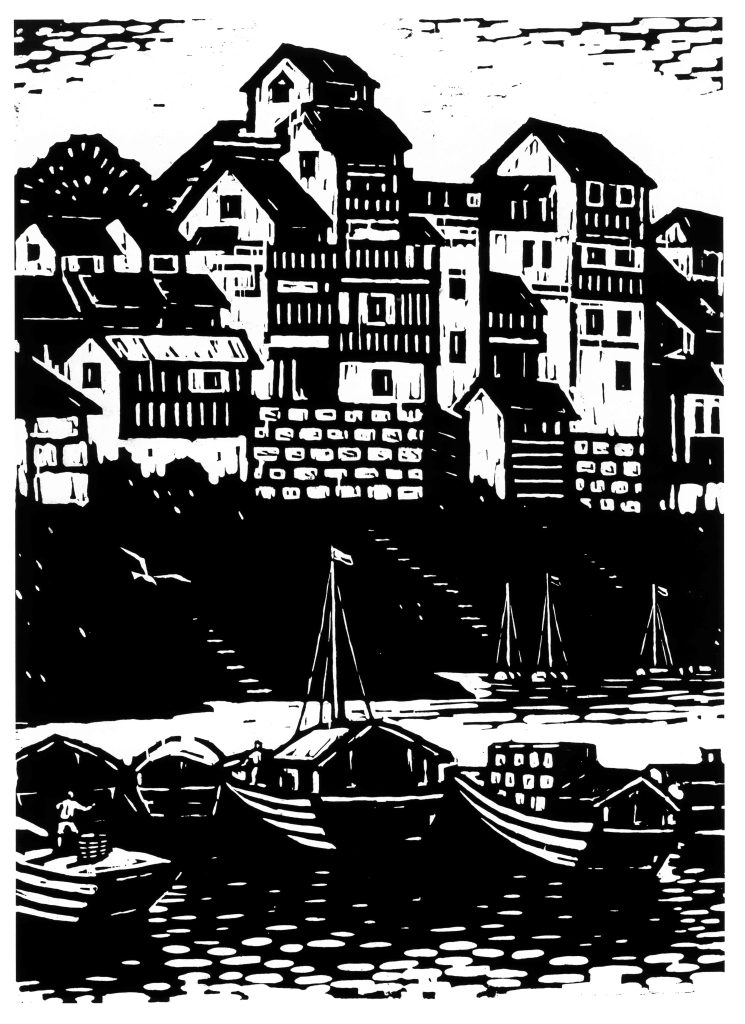
In 1979, Li Qun, who had traversed the regions along the Yangtze River for several years, meticulously depicted the “Yangtze River Landscape“. His affinity for diverse architectural styles is evident in his work. This masterpiece was subsequently featured in the “Sixth National Woodcuts and Printmaking Exhibition” held at the National Art Museum of China on November 8 of the same year.
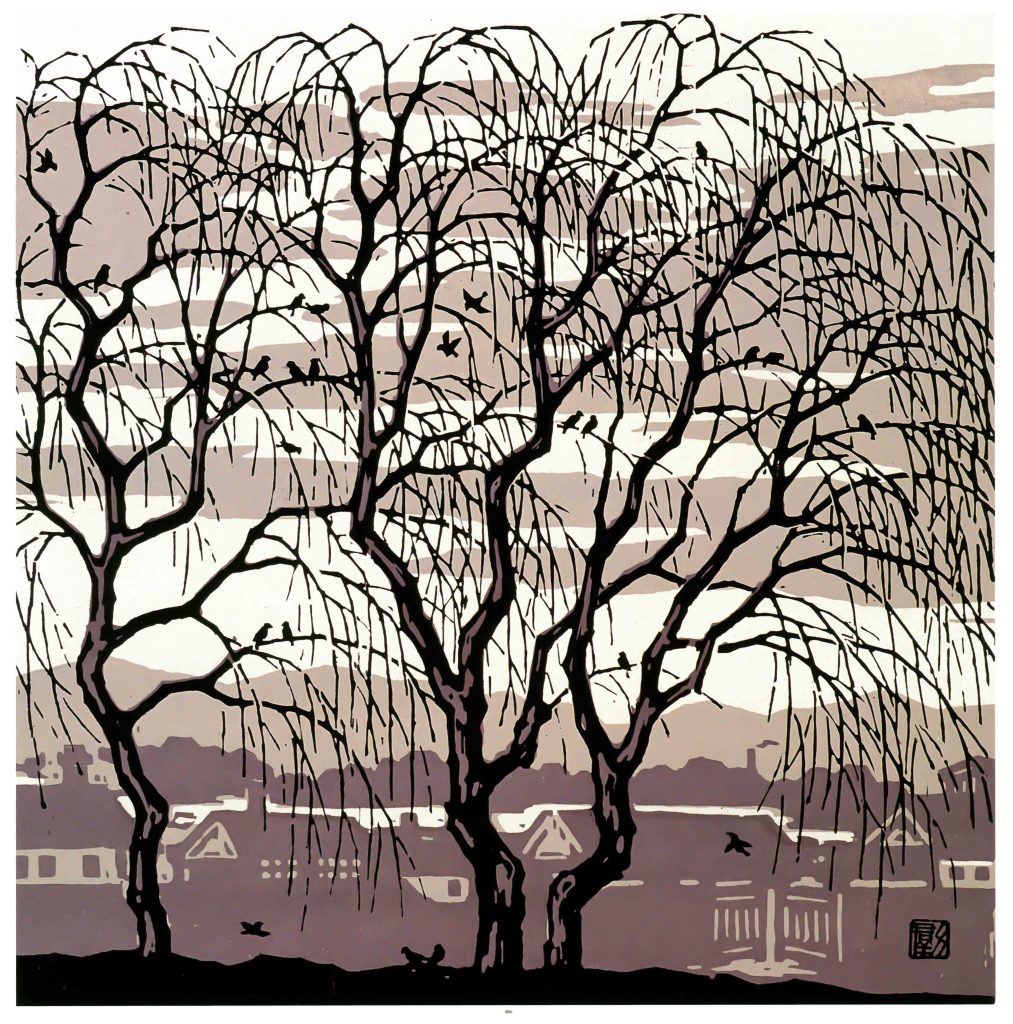
Inspired by the poetic and artistic sight of willow silk gently swaying in the cold wind outside his window, Li Qun sketched and created “Spring Breeze“. Although the Fen River in the artwork hasn’t fully thawed, the presence of white clouds, chirping birds, and the overall atmosphere signify the arrival of spring. Li Qun aptly named this woodcut, crafted in 1980, “Spring Breeze”. Astute observers can’t help but be transported into the warm spring ambiance depicted within the houses and people of the painting.
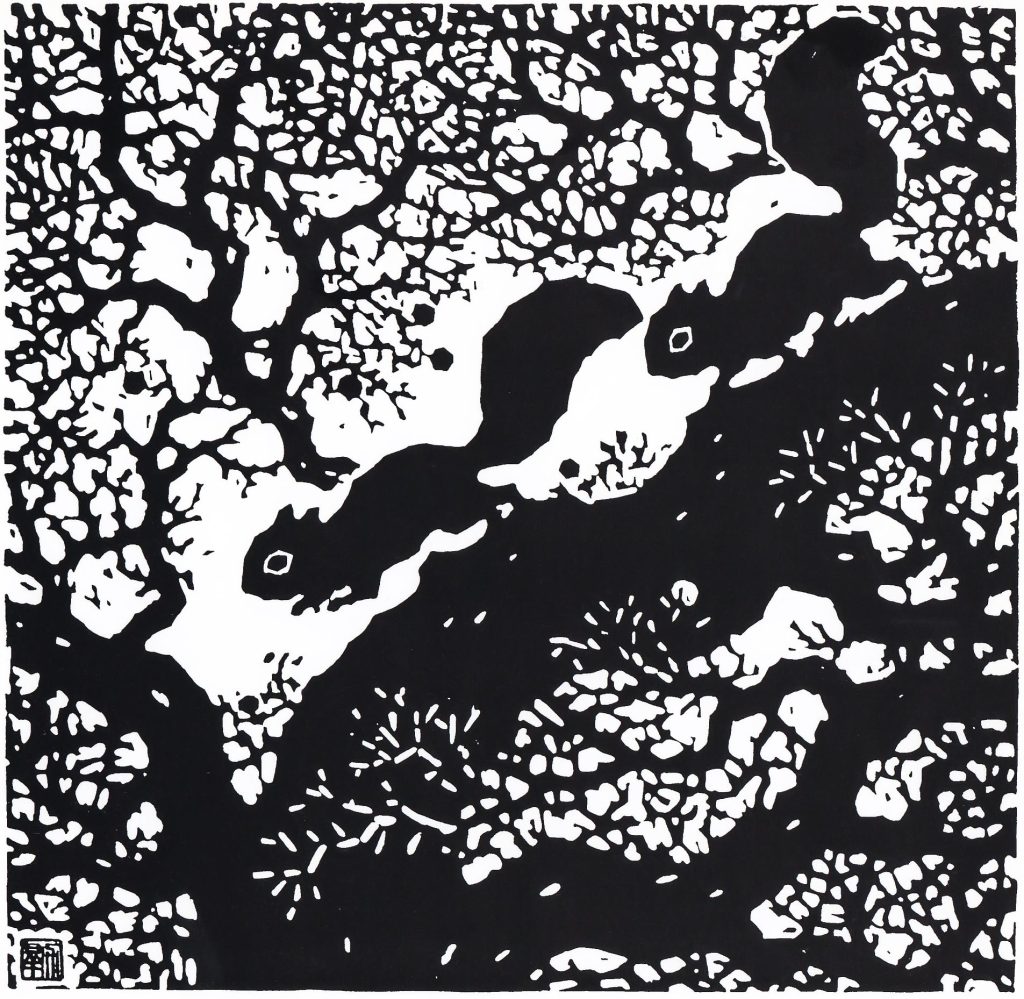
“In the Forest” crafted by Li Qun at the age of 69, gained widespread popularity. The squirrel featured in the artwork, affectionately known in Chinese as “Maogeli” in Li Qun’s hometown, held a special place in his heart since childhood. Even in his later years, he kept a squirrel in a cage. In late autumn 1978, while passing through Maiji Mountain upon his return from Xinjiang, Li Qun witnessed several squirrels frolicking on a tree with all its leaves—an enduring image. However, when he later sketched the scene, his youngest daughter A Xia remarked that it lacked cuteness. Reflecting on her observation, Li Qun realised it might have been too realistic. During the revision, he focused on enhancing facial expressions and introduced moderate exaggerations in the body. This adjustment garnered approval, and he carved it in a single session.
In March 1980, during the “Li Qun Woodcuts and Printmaking Exhibition” organised by the Shanxi Artists Association to commemorate the 50th anniversary of the left-wing cultural movement, “In the Forest” emerged as a crowd favourite. In April of the same year, at the founding ceremony of the China Woodcuts and Printmakers Association in Huangshan, spectators praised “In the Forest” affirming that “Li Qun never grows old”.
In 1983, “In the Forest” found a place in the National Library of France’s collection, subsequently being exhibited in six countries, including Tanzania and Ghana.
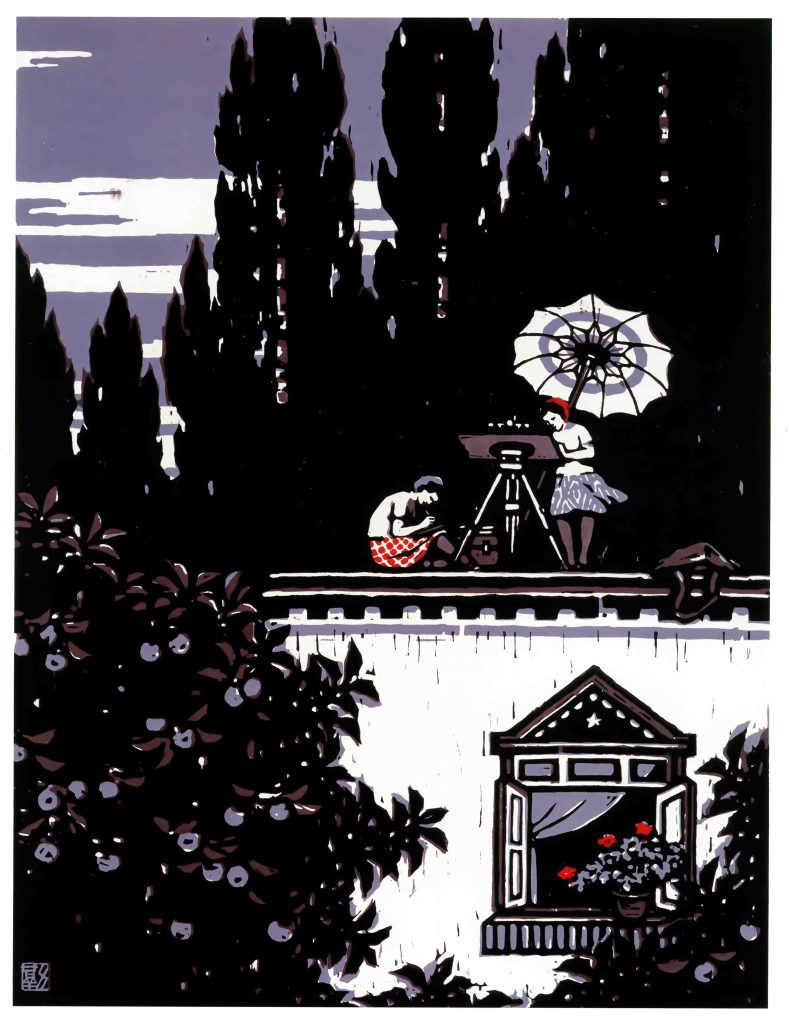
In 1978, Li Qun was invited to deliver lectures and provide guidance in woodcuts and printmaking training classes in Ili, Xinjiang. Seizing the opportunity, he collected ideas and produced numerous sketches and woodcut drafts. Crafted in 1980, the colour-blocked woodcut “A New Trend in Sight” portrays two Uyghur girls surveying and mapping on the rooftop of a house. Evidently, a new planning and design initiative is underway, heralding the anticipated construction of a new city.
During the initial stages of reform and opening up, a pervasive sense of optimism and hope for change permeated society. The vibrant depiction of potential prosperity in the artwork evoked a collective yearning for a better future.
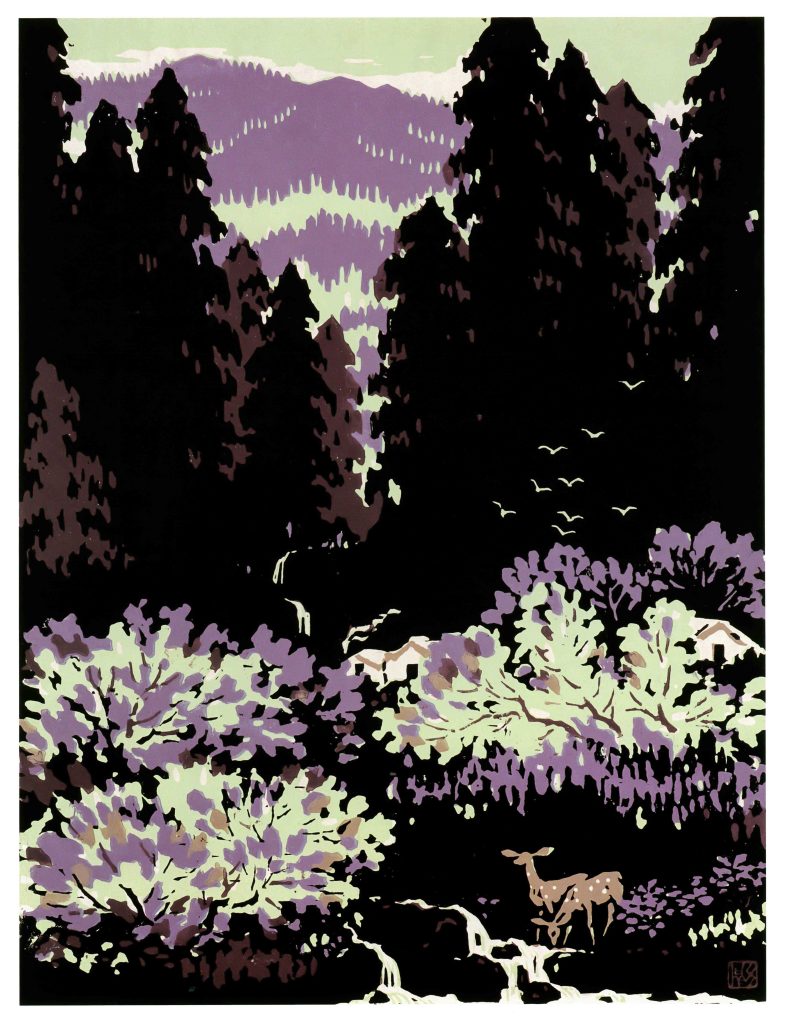
“Tianshan Summer” crafted by Li Qun in 1980 upon his return to Taiyuan, draws inspiration from sketches executed in the forests of the Xinyuan Forest Farm in Ili, Xinjiang. The painting deviates from a faithful representation of colours, opting instead for a bold approach using the hues found in the caisson patterns of the Dunhuang Grottoes. Ultramarine blue adorns the shrubs, while the sky is painted in refreshing greens, resulting in an extraordinary and captivating colour palette.
The artwork portrays towering pine trees, crystal-clear waterfalls, deer quenching their thirst nearby, and a distant corner of a tent. Concealed within the lush and vibrant scenery are the endeavours of forestry workers. Despite the midsummer setting, the painting imparts a sensation of coolness and beauty to its observers.
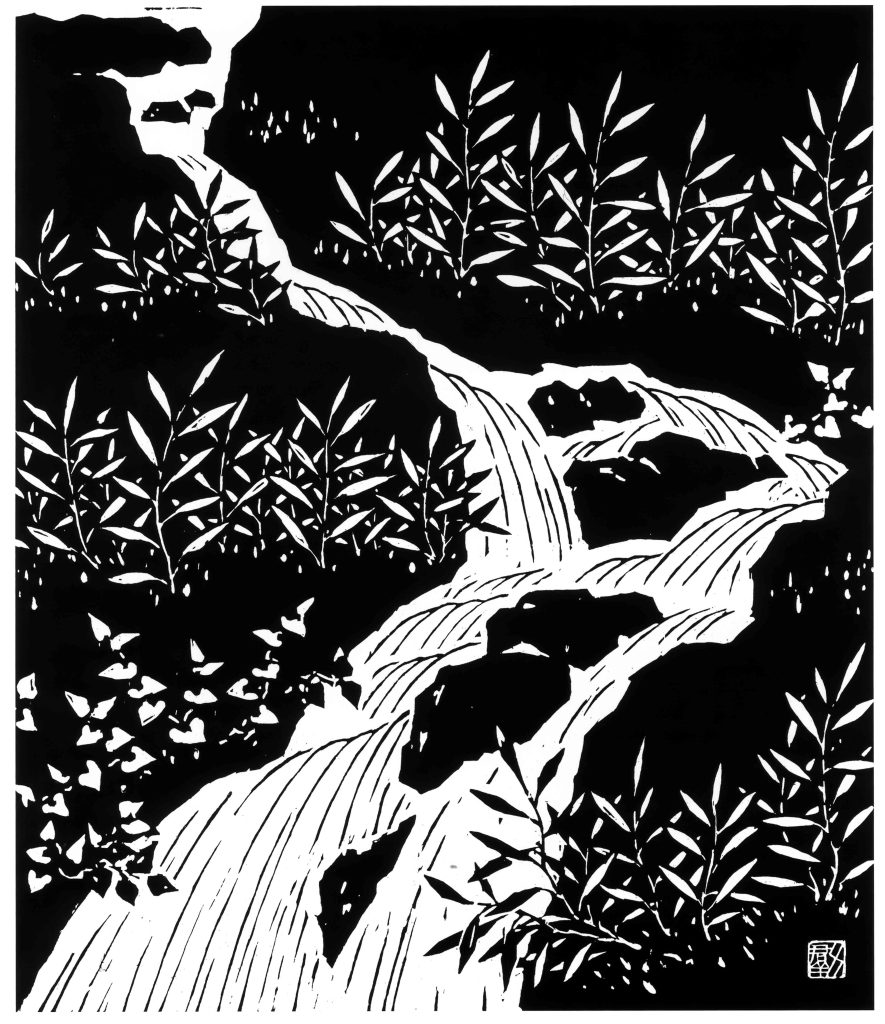
“Clear Spring” conceived by Jiu Yi and painted in 1980, exemplifies a distinct Chinese woodcut style. In 1981, the artwork was featured in the “50th Anniversary Exhibition of Emerging Woodcuts in China” held by the “French-China Friendship Association” at the Grenopol City Cultural Center. Li Qun’s “Clear Spring” adorned the exhibition poster, and the album cover released concurrently showcased “Clear Spring” with a 4/5 layout.
Traditionally, it was believed that the prevalence of black patches in woodcut images characterised Western woodcuts. In an effort to adhere to a national style and align with Chinese aesthetic preferences, woodcut images were technically crafted with minimal black patches, employing more positive lines. Li Qun’s evolving understanding, influenced by traditional Chinese calligraphy, various calligraphy rubbings, and picture rubbings, led him to question why Chinese prints couldn’t be rendered against a black background.
With this revelation, “Clear Spring” boldly embraced a significant black area to enhance the depiction of flowing spring water. Water plants, swayed by the breeze, were delicately scattered along the water’s edge. The result was a vivid portrayal exuding a distinctive Chinese spirit. Unsurprisingly, “Clear Spring” received acclaim both in China and abroad, with one watercolour painter expressing that, having seen it at an exhibition in Guangzhou, “Clear Spring” surpassed even “In the Forest”.
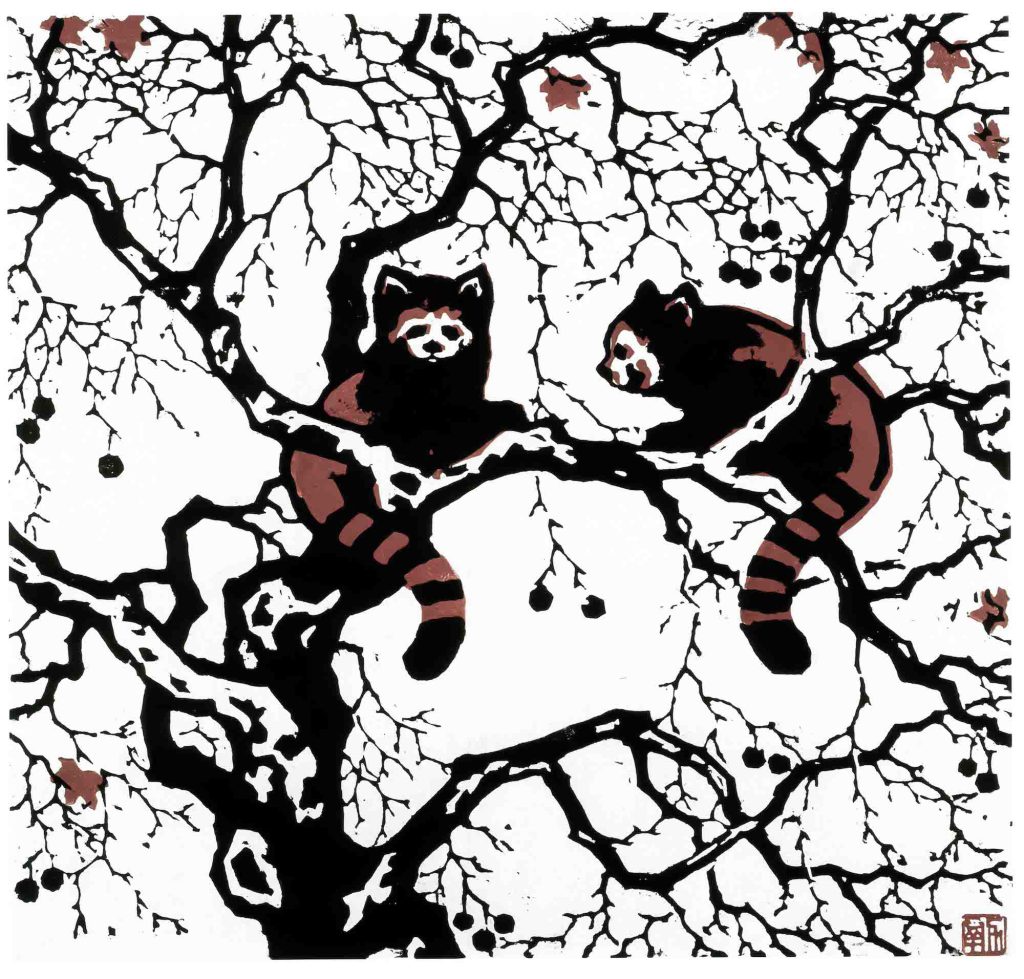
The creation of “Red Panda” originated in Changsha, Hunan. In 1981, during a lecture tour in Hunan, Li Qun visited Changsha Zoo and sketched his beloved red panda. Additionally, in the hotel courtyard during this period, he captured the essence of a rare northern French plane tree on canvas. Upon returning to Taiyuan, he transformed his sketches into the artwork “Red Panda” which went on to participate in the “Chinese Printmaking Exhibition” held in Denmark in 1983.
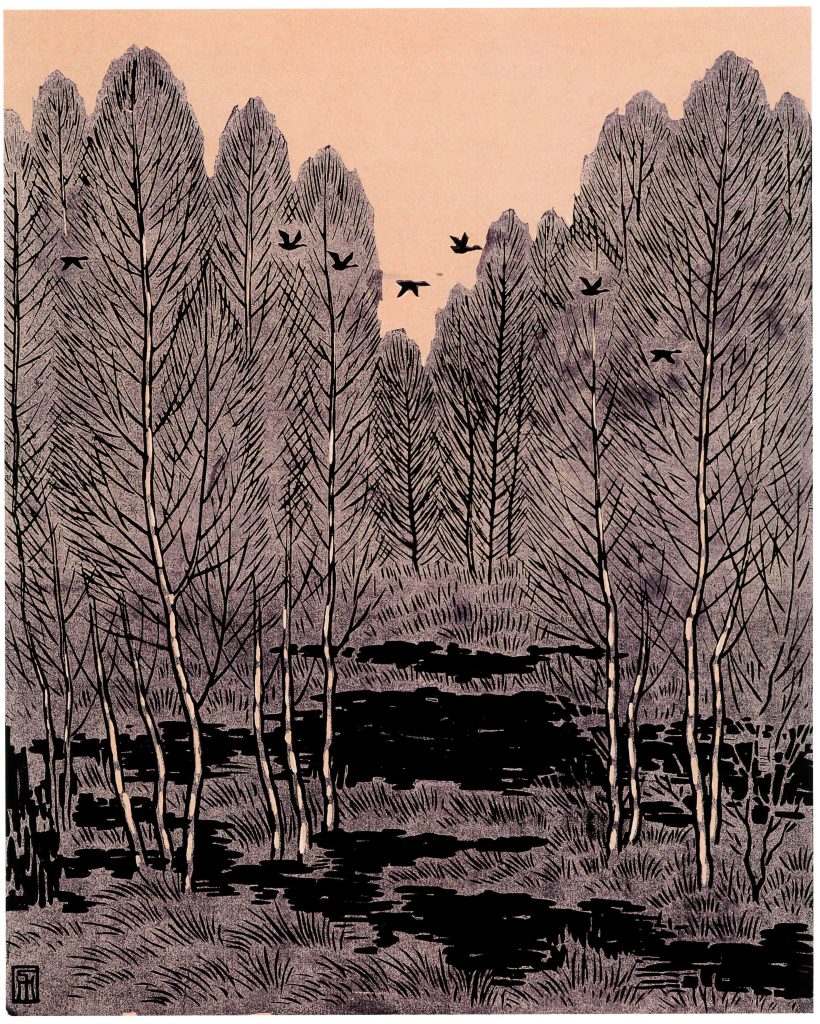
“Early Spring in the Northland” crafted in 1981, is widely regarded as one of Li Qun’s masterpieces from the 1980s. This painting made an appearance at the 1982 Art Exhibition in Paris, specifically at the Spring Salon Exhibition. In 1980, Li Qun, alongside printmaker Du Hongnian, journeyed to Heilongjiang, where they sketched various scenes, including one along the Huma River depicting red willow bushes in the swamp—later becoming the basis for “Early Spring in the Northland” a piece showcased in the 1982 Paris exhibition.
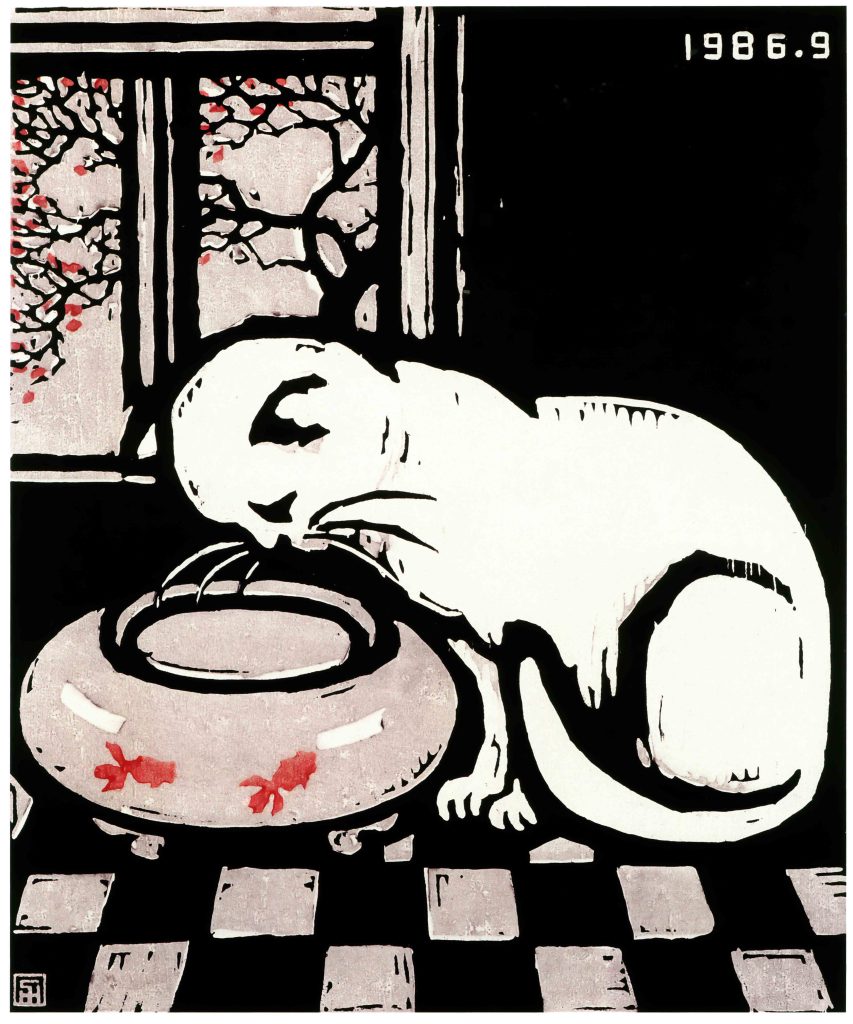
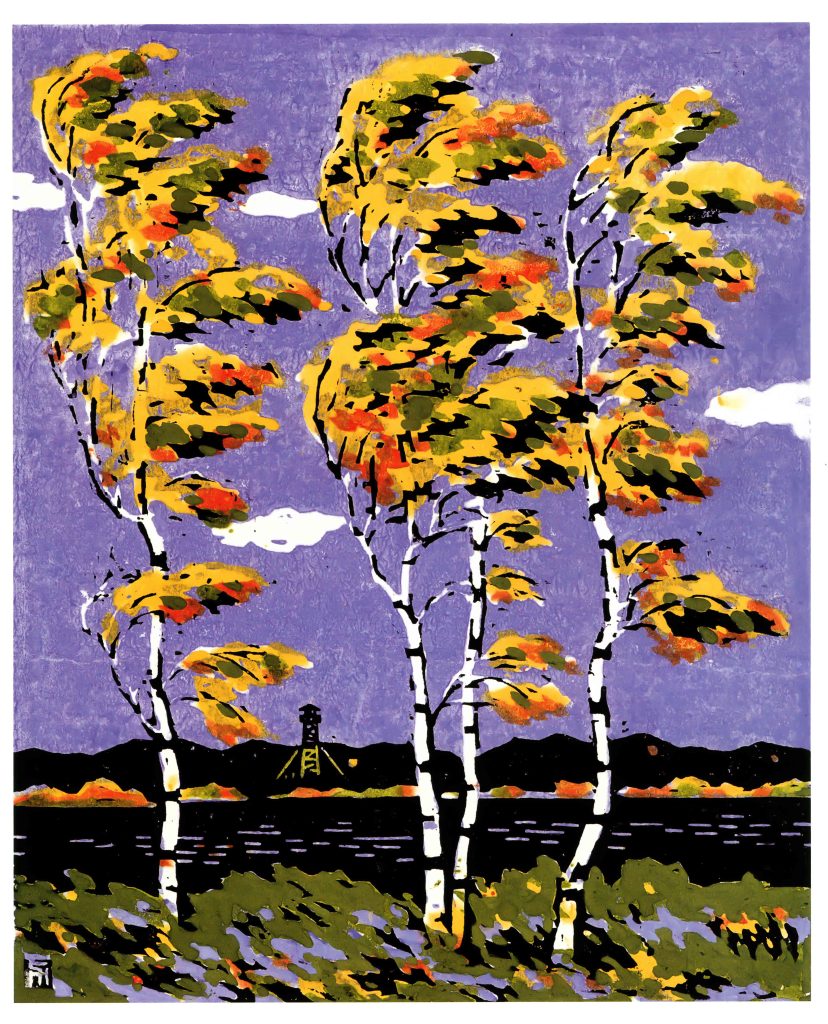
In 1980, Li Qun and printmaker Du Hongnian embarked on a journey to the Heilongjiang River. The mid-autumn scene unfolded with birches and poplars along the shore bathed in golden hues. Set against the distant blue mountains, the spectacle was breathtaking and left a lasting impression on Li Qun. Upon returning to Taiyuan, he recreated the enchanting scenery in the painting “Heilongjiang Autumn“.
Across the Heilongjiang River stood the Soviet Union’s “Observation Pavilion”. In an era marked by uneasy Sino-Soviet relations, did the elements within the artwork echo a call for peace or serve as a warning? The painting, with its subtle nuances, leaves room for readers to interpret and ponder.
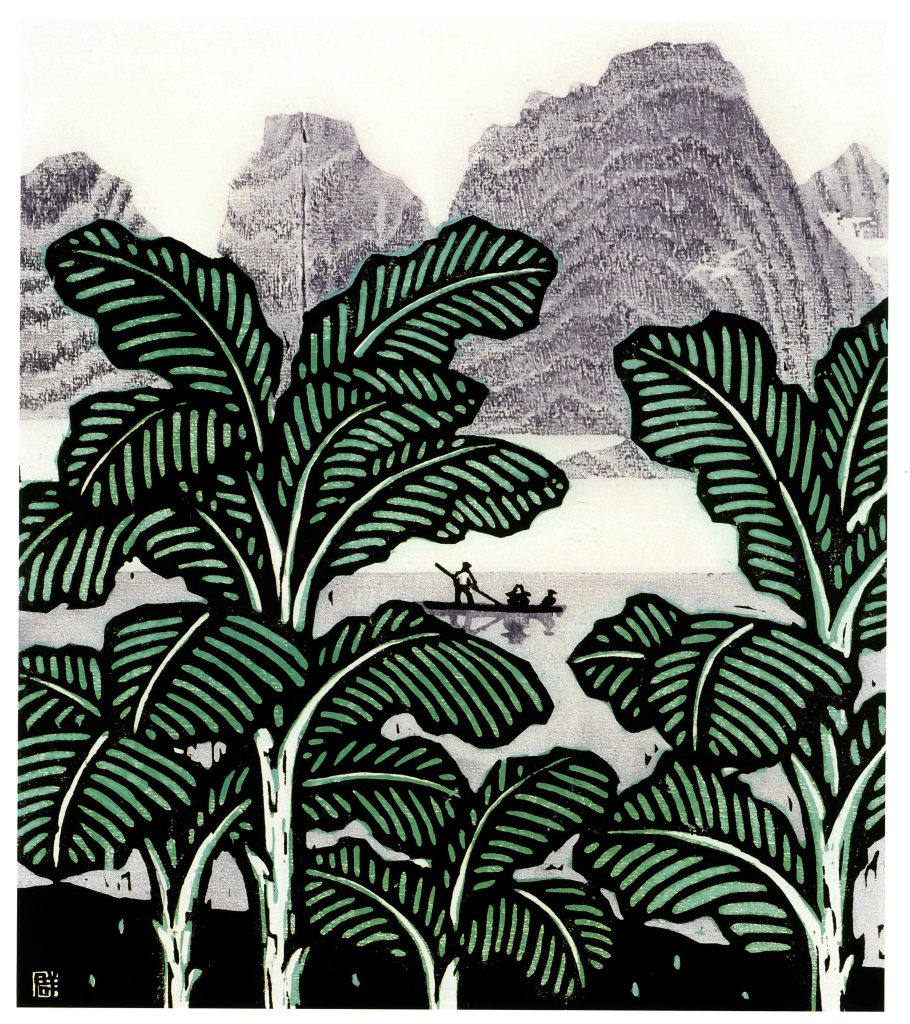
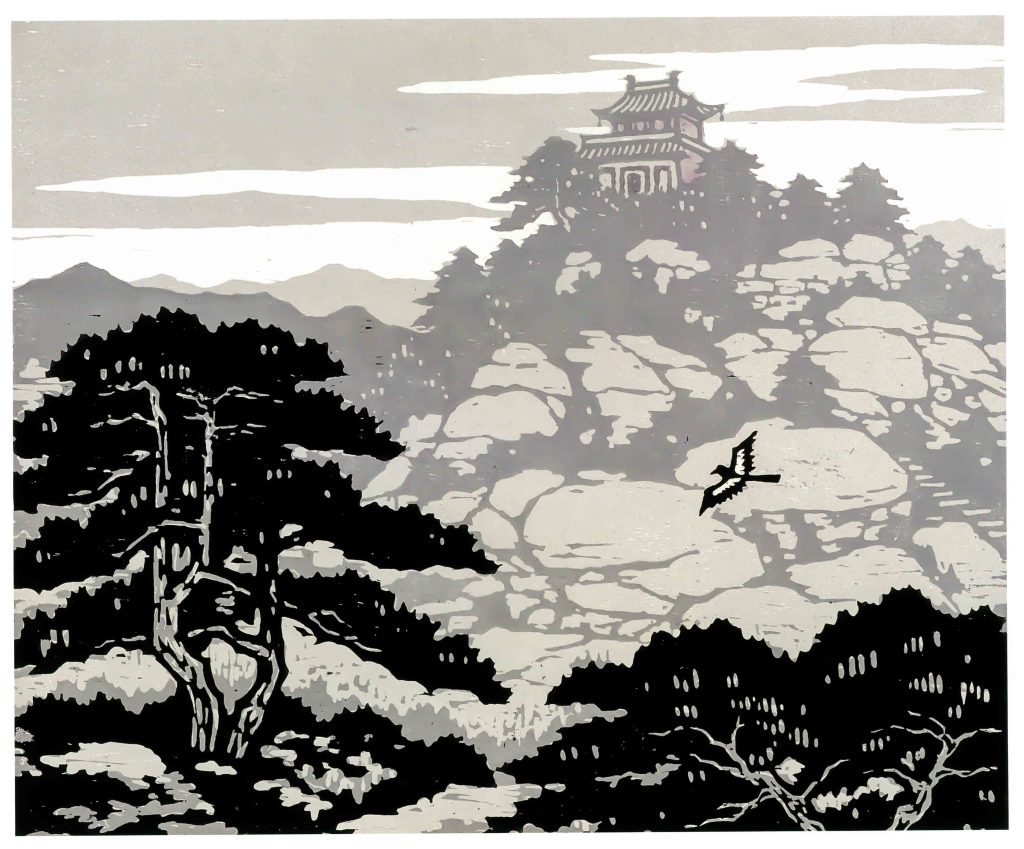
North Wudang Mountain, known as “Zhenwu Mountain” and “Dragon King Mountain” in ancient times, is situated in Fangshan County within the Luliang Mountains of Shanxi Province. It stands as one of the Taoist sacred sites in northern China, designated as a national key scenic spot. In 1991, Li Qun visited this serene locale, spending a night in the grotto beneath the Zhenwu Temple before ascending to the temple the following day. During his descent, he sketched the Zhenwu Temple from Guisheling, capturing the essence of the scene and later creating “North Wudang Mountain“. The painting exudes nobility and elegance, seamlessly blending movement and stillness, while a magpie gracefully enters the frame, imparting an ethereal quality to North Wudang.
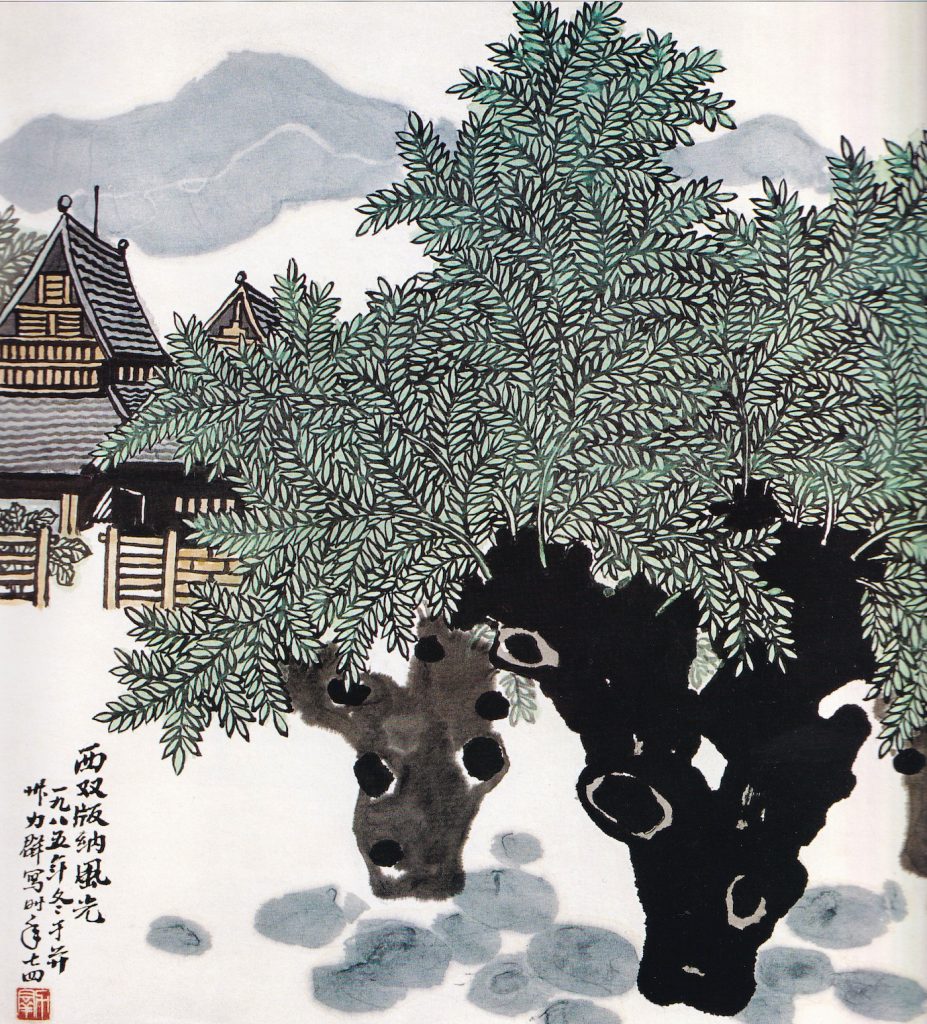
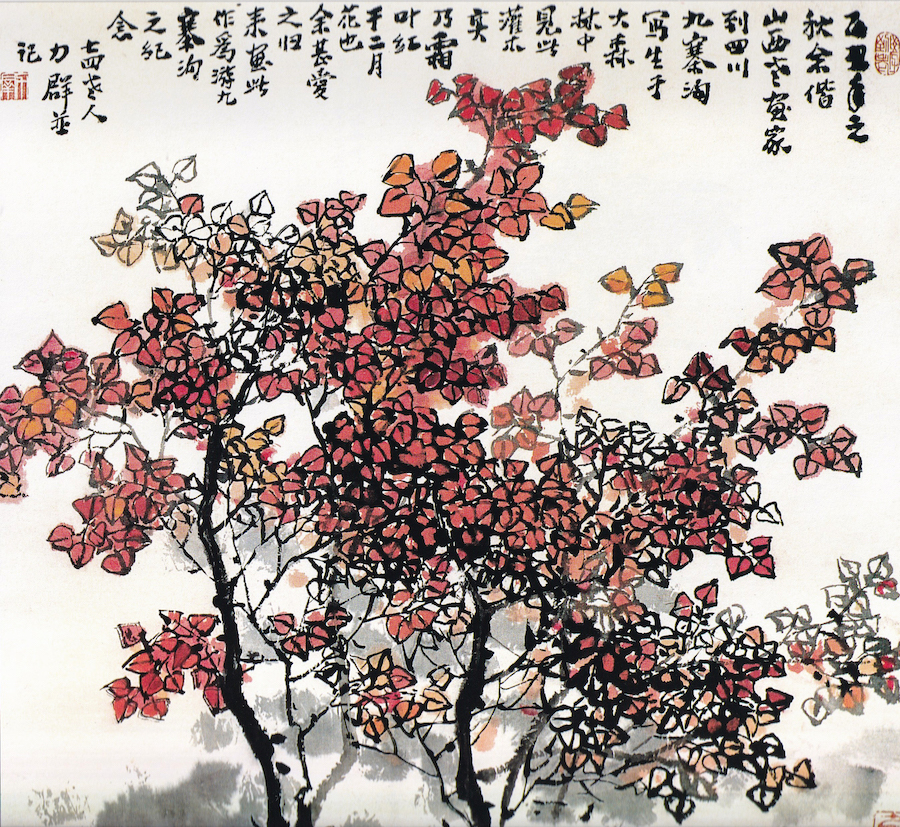
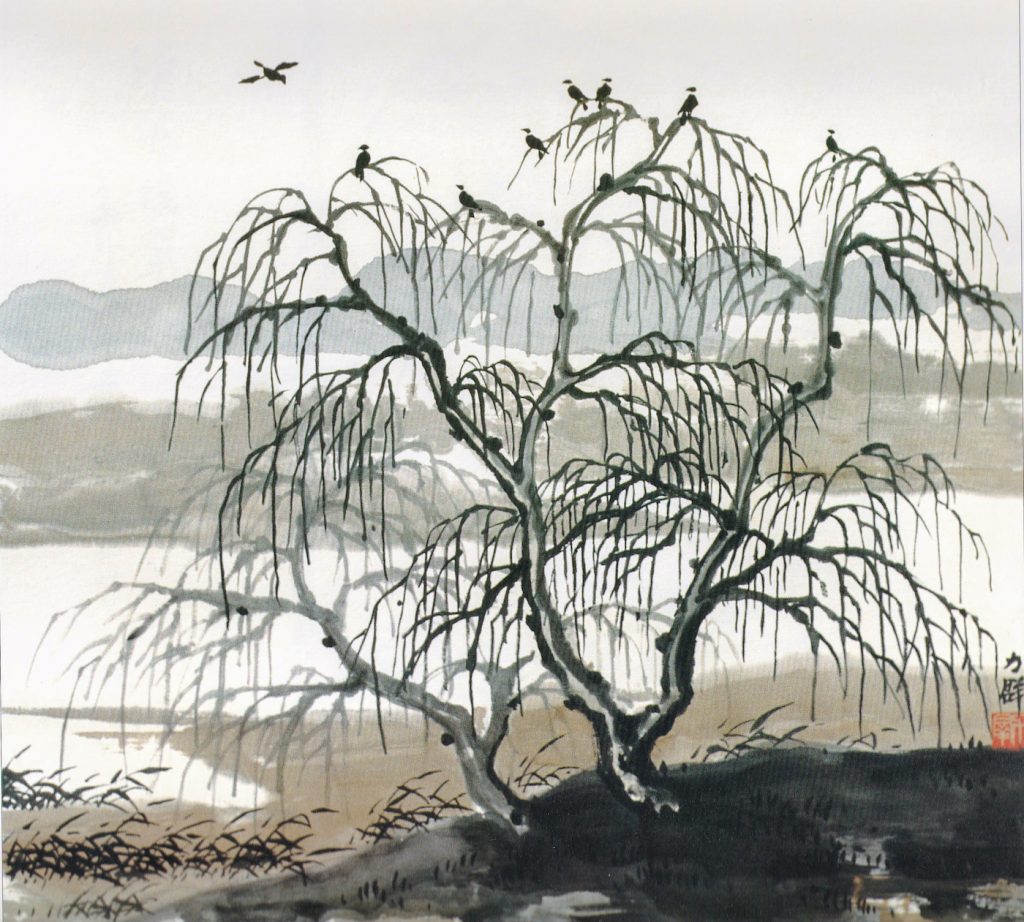
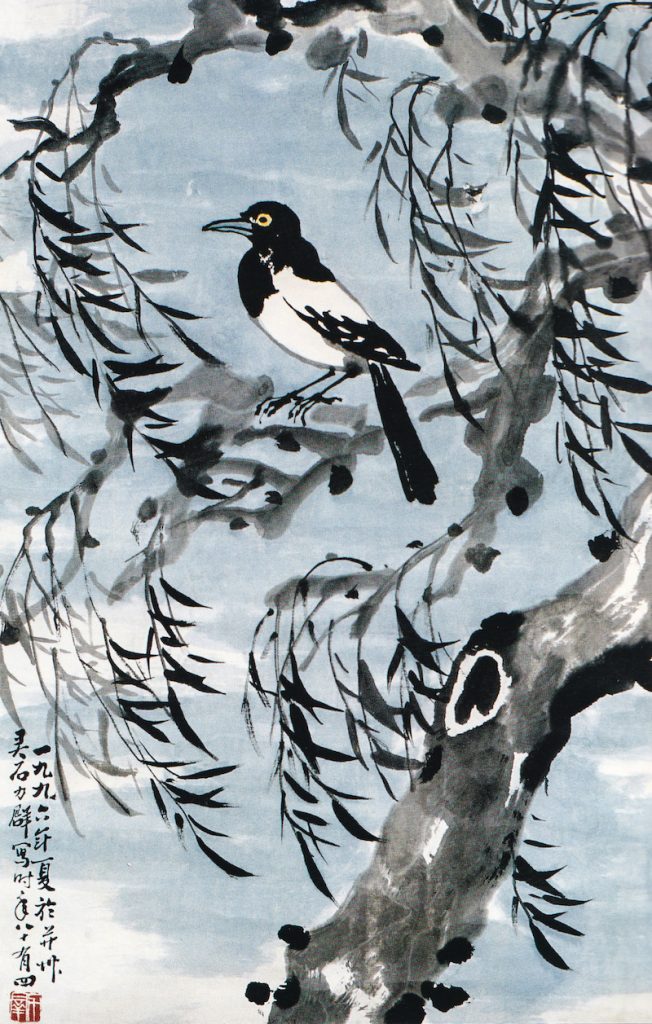

A village childhood Li Qun’s roots trace back to a quaint mountain village, an enclave characterised by a mere six
A fervent and spirited young man, deeply moved by the news of the “September 18th” incident, found himself compelled to
Following the Marco Polo Bridge Incident on July 7th, a significant event unfolded in Shanghai known as the “August 13th”
In Li Qun’s contemplation, Yan’an had long been the revered sanctuary he ardently sought. Communist Party members and numerous progressives
In August 1945, following the Japanese surrender, Liqun bid farewell to Yan’an, where he had dedicated six years of work
Following the inaugural national literary congress, Li Qun adhered to Comrade Zhou Yang’s directives and returned to Shanxi to collaboratively
During the tumultuous period of the “Cultural Revolution,” Li Qun, like many writers and artists, faced severe hardships and endured
With the demise of the “Gang of Four,” a wave of joy swept across China. Li Qun, like countless others,
Determining precisely when Li Qun entered old age proves challenging, given the considerable gap between his vitality and chronological age.
In memory of Li Qun (1912-2012)
Our mission is to safeguard and champion Li Qun’s artistic legacy and literature for the benefit of future generations. This digital memorial stands as a tribute to Li Qun’s lifetime of artistic brilliance.
Our pledge is to meticulously document and categorise every piece of art created by Li Qun, creating a comprehensive resource for enthusiasts and scholars alike. Furthermore, we are committed to preserving his gallery, the Li Qun Art Gallery, and promoting Lingshi county, Taiyuan city and Shanxi province.
Delve into our extensive online catalogue, uncover the curated locations of Li Qun’s art, or visit the Li Qun Art Gallery located in the culturally rich Wang Jia Da Yuan. Set against the backdrop of the heritage-listed Wang’s Family Compound, a Qing Dynasty mansion, the gallery seamlessly blends art and tradition.
Explore the profound impact of Li Qun’s artistic journey, through both the visual realm and the literary dimensions of his work.
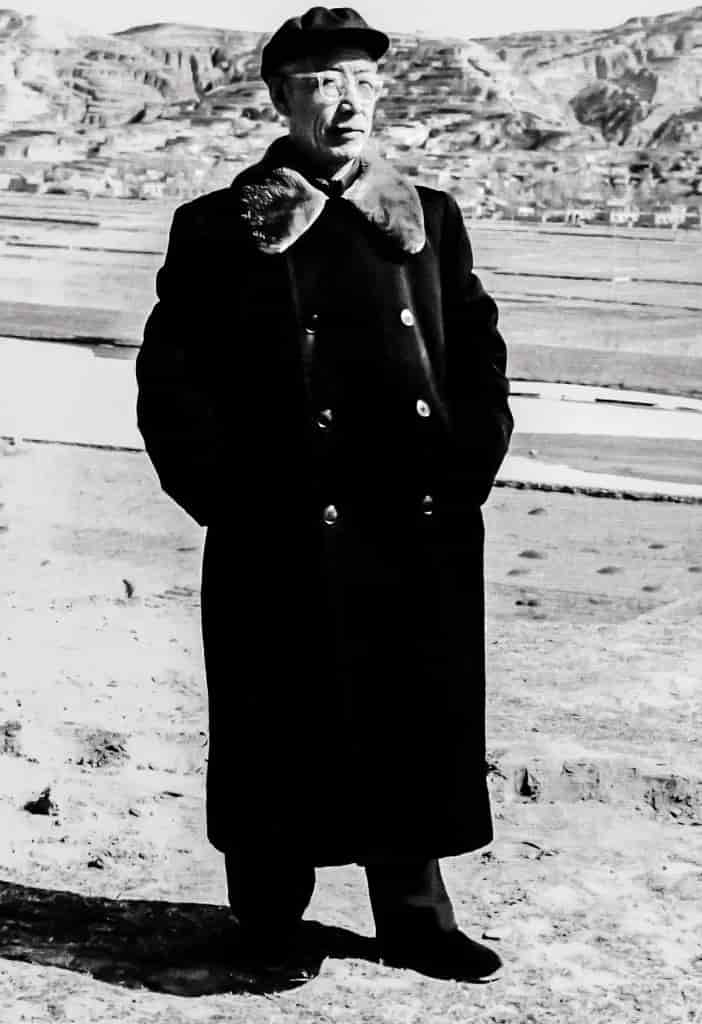
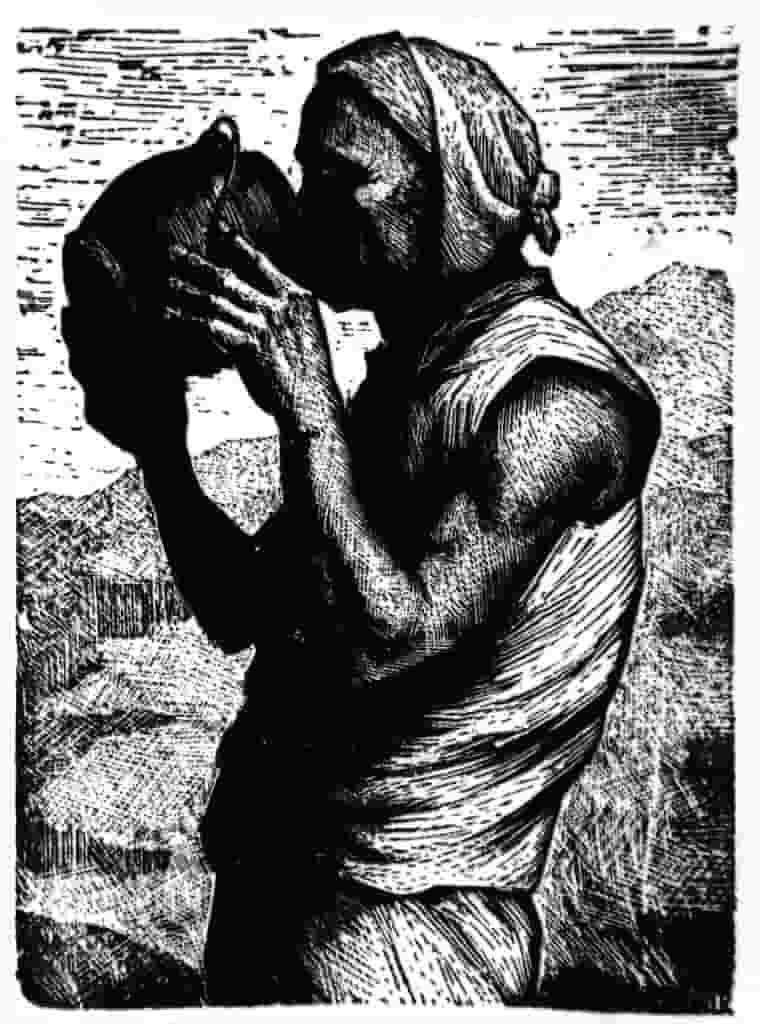

A village childhood Li Qun’s roots trace back to a quaint mountain village, an enclave characterised by a mere six courtyards and ten households in its nascent years. This hamlet, situated in Lingshi County, Shanxi Province, earned its identity as Hao Jia Zhang. Positioned to the east of Fenhe River,
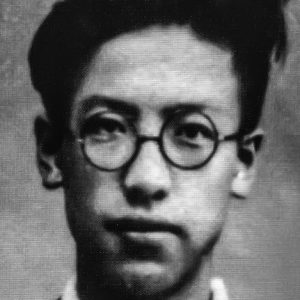
A fervent and spirited young man, deeply moved by the news of the “September 18th” incident, found himself compelled to resist the aggressive incursions of Japanese imperialism on Chinese soil. Unwilling to acquiesce to a policy of non-resistance before aggressors or to tolerate any actions undermining national prestige, the young
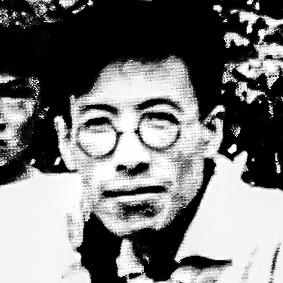
Following the Marco Polo Bridge Incident on July 7th, a significant event unfolded in Shanghai known as the “August 13th” Anti-Japanese War. It marked a critical juncture for the Chinese nation, prompting a collective response from those unwilling to endure subjugation. The call to action resonated with the spirit of
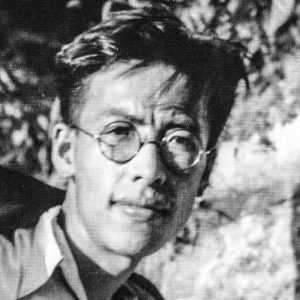
In Li Qun’s contemplation, Yan’an had long been the revered sanctuary he ardently sought. Communist Party members and numerous progressives within the “Wuhan Third Office” had already developed a certain level of “Yan’an Fever”. Although Li Qun was not yet a Communist Party member at that time, Guang Weiran had
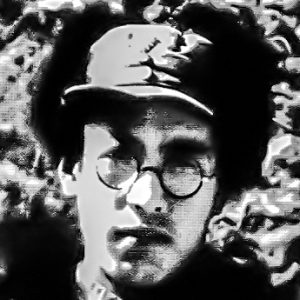
In August 1945, following the Japanese surrender, Liqun bid farewell to Yan’an, where he had dedicated six years of work and life. He arrived in Xingxian County, Shanxi Province, which served as the political and cultural hub of the Shanxi-Suiyuan Border Region. There, he assumed the role of chief editor
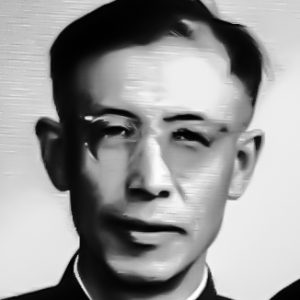
Following the inaugural national literary congress, Li Qun adhered to Comrade Zhou Yang’s directives and returned to Shanxi to collaboratively establish the Shanxi Federation of Literary and Art Circles with Comrade Gao Muhong. In December 1949, the first literary congress of Shanxi Province was successfully convened, electing Gao Muhong as
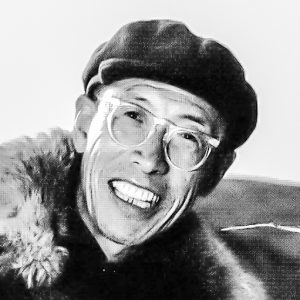
During the tumultuous period of the “Cultural Revolution,” Li Qun, like many writers and artists, faced severe hardships and endured humiliation. Initially transferred back to Shanxi in early 1966, the upheaval of the “Cultural Revolution” saw him forcefully returned to Beijing, labeled as part of the “gangster” team of “reactionary
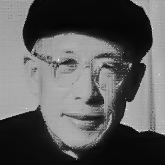
With the demise of the “Gang of Four,” a wave of joy swept across China. Li Qun, like countless others, found himself advancing into a new chapter in the aftermath of the storm, standing beside the “sinking boat” and the “ailing tree” during a time of tremendous possibilities.
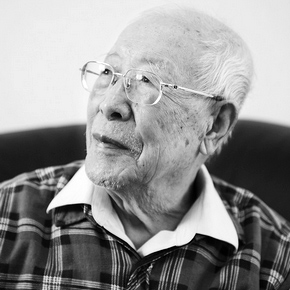
Determining precisely when Li Qun entered old age proves challenging, given the considerable gap between his vitality and chronological age. As mentioned earlier, even in his 70s during the reform and opening up era, he exhibited a spirit that belied his years. Approaching 80, on the cusp of the new
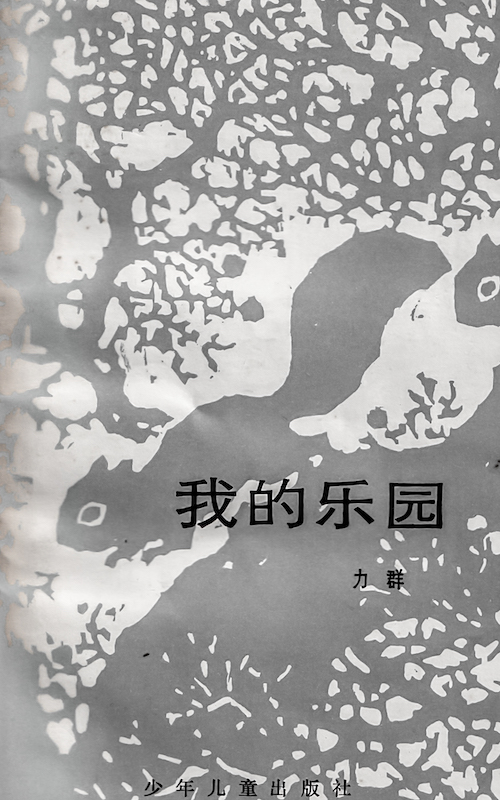
The pure and lively sensibilities of children, influenced by nature, the memorable and relatable people encountered during youth, and the longing of young minds for life and his emotional reflections. These themes permeate the work of the acclaimed woodcuts artist Li Qun. In this book, Li Qun skilfully intertwines literature
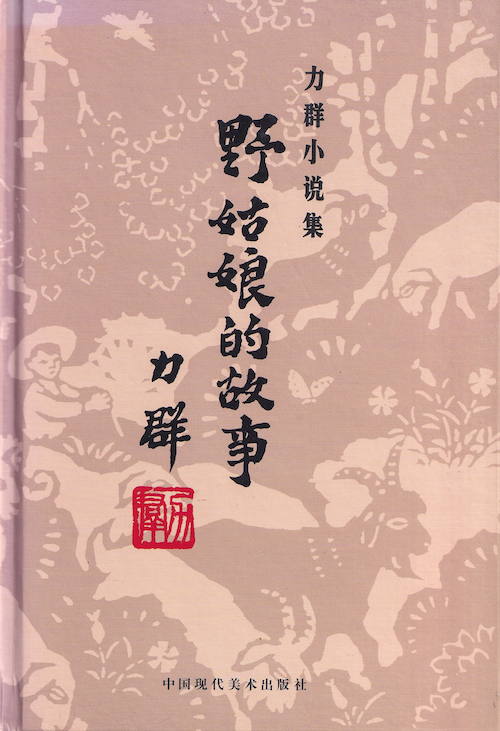
In the remote mountain village of Shanxi Province, Guilian grows up without her mother’s love, facing her father’s bitterness and the superstitions that label her unlucky. Despite harsh circumstances, she finds solace in nature and solitude. As she matures, Guilian’s resilience becomes her strength, defying her father’s attempts to sell
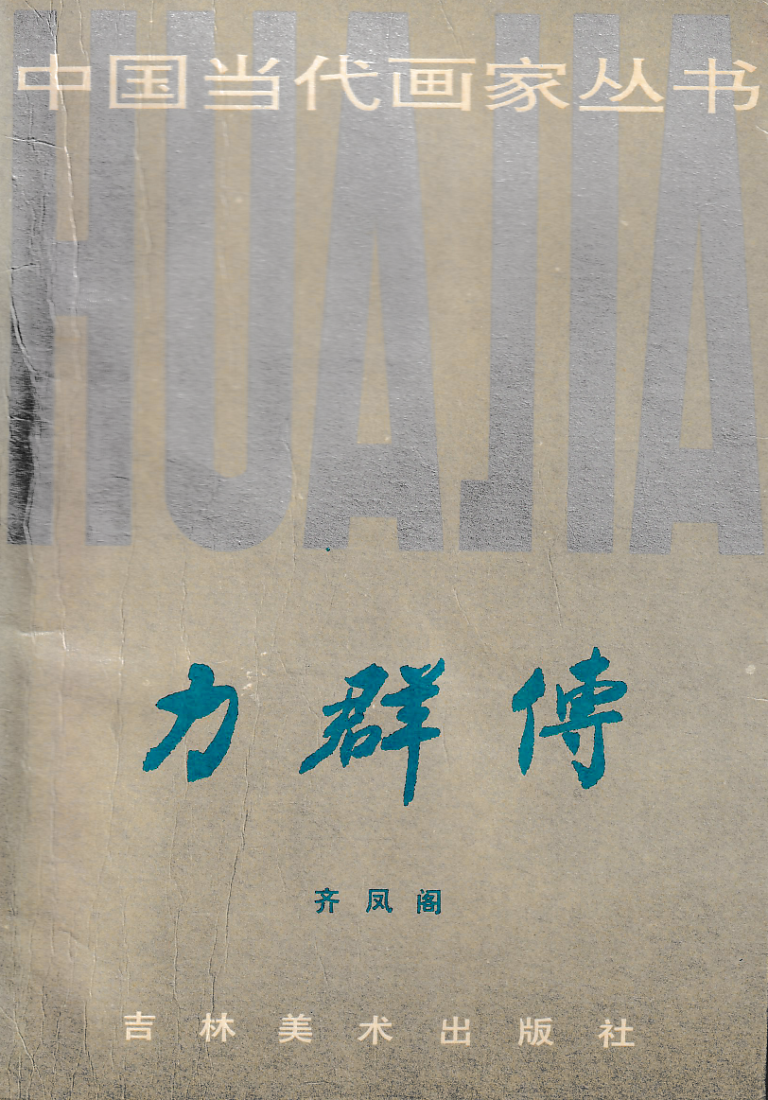
Li Qun the renowned woodcuts artist from Shanxi has weathered numerous challenges and remained committed to self-improvement, guided by unwavering beliefs and relentless determination. His journey from rural origins to urban landscapes, from the city to Yan’an, reflects his resilience and perseverance amidst life’s trials. This book not only chronicles

An autobiography penned by the renowned Chinese woodcuts artist Li Qun. Through a blend of documentary techniques, Li Qun vividly recounts the twists and turns of his career, tracing his creative journey and artistic evolution over the past century. This captivating autobiography immerses readers in the rich tapestry of historical
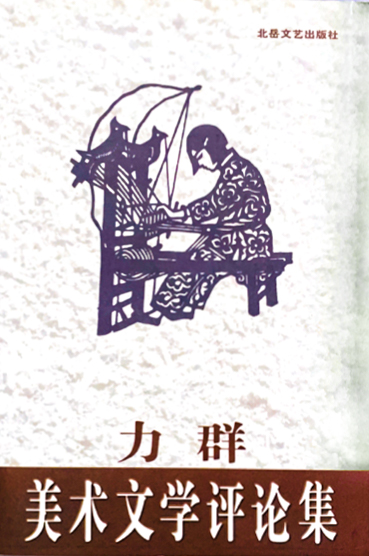
Li Qun renowned woodcuts artist who has been engaged in artistic creation for nearly 60 years. He persists in both printmaking and literary creation, and is also involved in Chinese painting. Additionally, he is a well-known art critic. His prints are characterised by their simplicity, clarity, and lyrical colours, reflecting
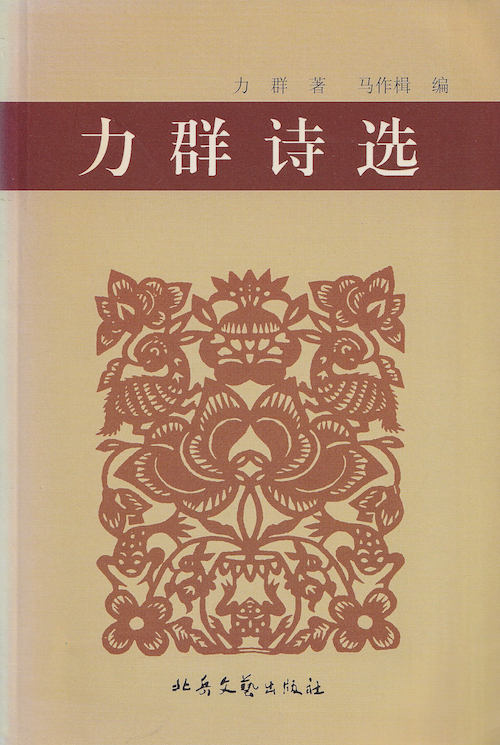
“Selected Poems of Li Qun,” compiled by the artist himself, finding its verses rich in sincerity, vivid imagery, and melodious rhythms. Divided into three volumes with a total of 88 poems, the collection showcases Li Qun’s deep emotions, artistic vision, and linguistic precision. Each poem resonates deeply, ranging from tranquil
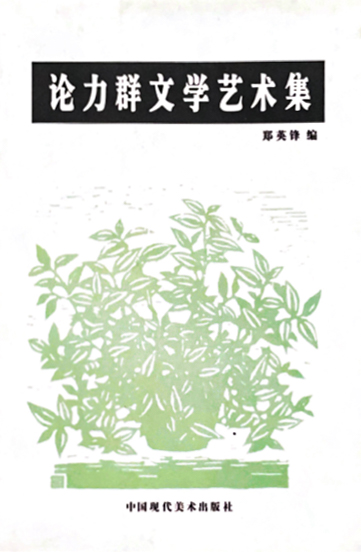
Li Qun, born on December 25, 1912, in Haogia Village, Shanxi Province, has been involved in art for nearly 60 years. He grew up in a rural environment, which greatly influenced his woodcut creations and writings. Li Qun studied at the National Hangzhou Art Specialized School and later joined the
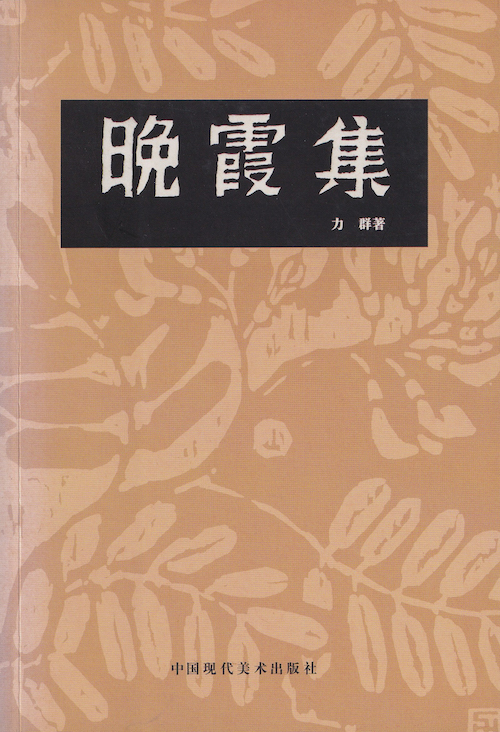
Li Qun, known primarily as a woodcuts artist showcases his literary talents alongside his passion for painting in an anthology spanning novels, essays, and critiques. The collection starts with “The Story of the Wild Girl,” a moving novel, followed by serene prose pieces like “My Paradise” and “Hua Orchid.” His
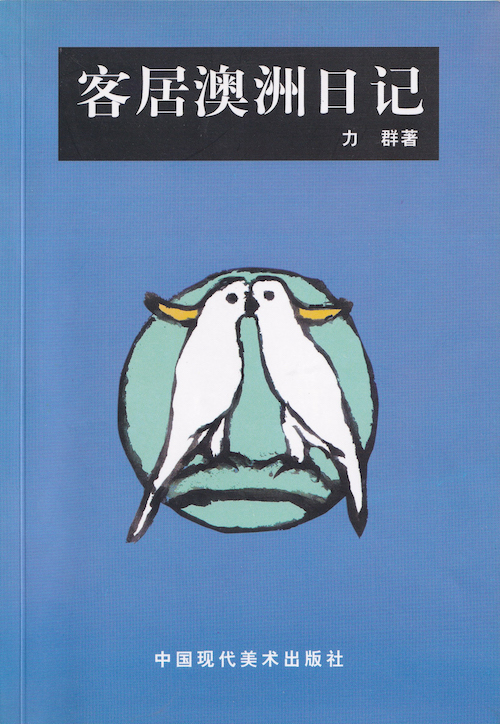
In December 1994, Li Qun embarked on a five-month journey to Australia, chronicling his experiences in “Diary of living in Australia.” Through daily entries, he contrasts the climate, environment, and cultural interests of Australia with the mainland. Sydney’s wildlife, especially the playful parrots, captivated him, as shared in his letter
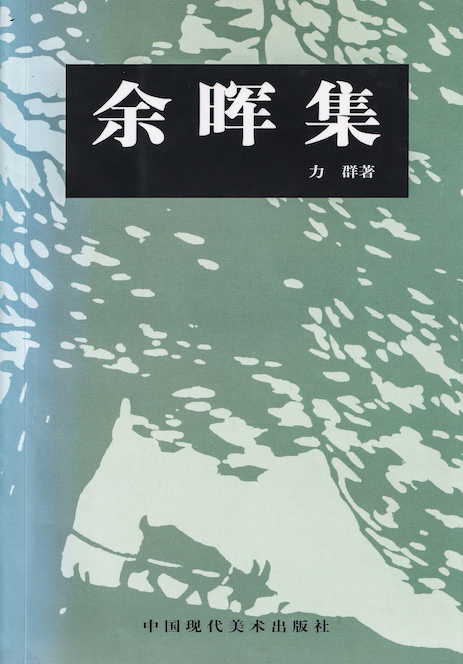
The “Afterglow Collection” signifies the culmination of Li Qun’s literary journey following the “Sunset Collection”. Within its 34 articles, each holds significance. Particularly noteworthy is “The Eternal Navigation Lighthouse,” detailing the “Yan’an Forum on Literature and Art” exploring its historical impact and contemporary interpretation. “My Creative Path” delves into personal
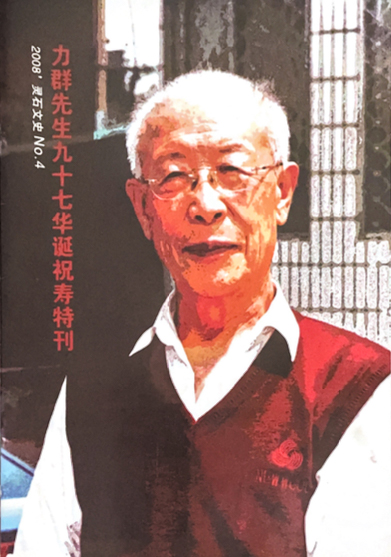
Congratulations – To Mr. Li Qun, a renowned Chinese printmaker, writer, literary critic, and local luminary. Respected Mr. Li Qun: Today marks your 97th birthday. First and foremost, please allow us, on behalf of the Ling Shi County Committee, Government, People’s Congress, Political Consultative Conference, and all 240,000 residents of
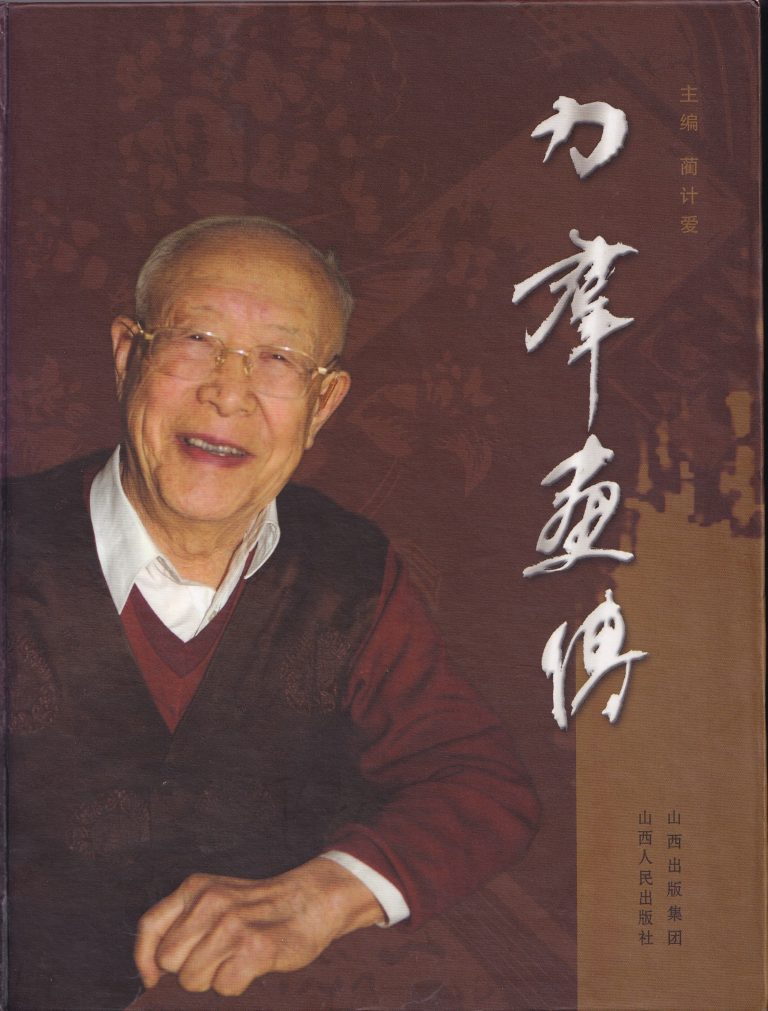
The forthcoming “Picture Biography of Li Qun” provides an in-depth look into the life and artistic journey of this revered figure. From his humble beginnings in Shanxi to becoming a pioneering force in China’s woodcuts and printmaking movement. Li Qun’s unwavering commitment to his craft endured personal and political challenges.
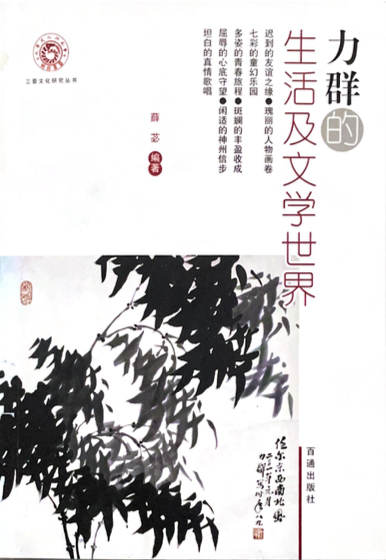
Li Qun, in my view, is a remarkable figure of his generation. Decades ago, I came across his woodblock prints in the “Jin Sui Daily,” and they truly captivated me. He had connections with the cultural giant of China, Mr. Lu Xun, as early as the 1930s. He was the
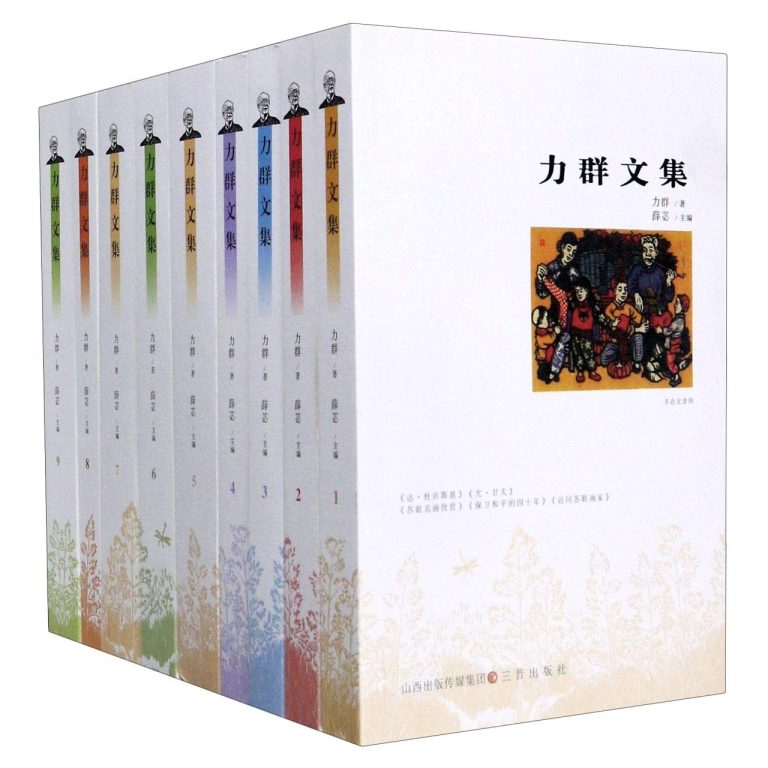
“The Complete Works of Li Qun” is a comprehensive nine-volume collection that showcases Mr. Li Qun’s dedication and creative accomplishments across various fields such as woodcut paintings, essays, novels, and literary critiques. Each volume stands as a complete entity, offering readers a glimpse into Mr. Li Qun’s artistic evolution from
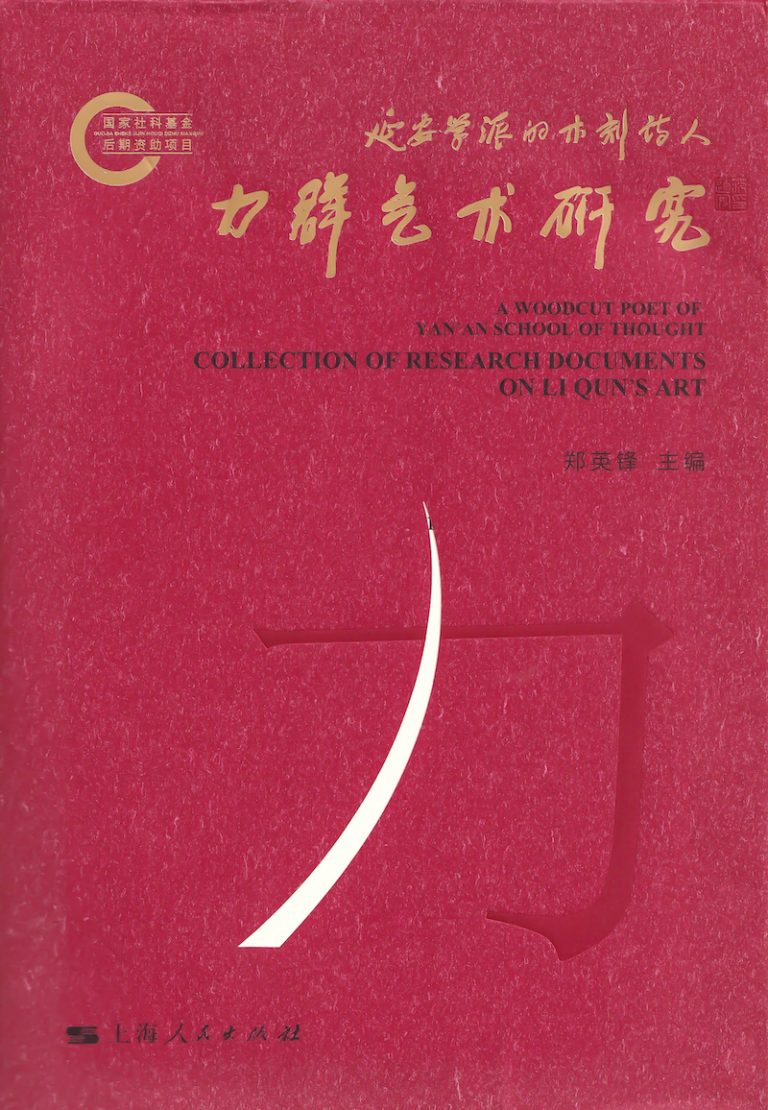
Li Qun is a prominent figure in the emerging woodcut printmaking movement in China and embodies the poetical spirit of the “Yan’an School.” He has had a significant influence on the development of modern printmaking in China. From a young age, he dedicated his art to the great cause of
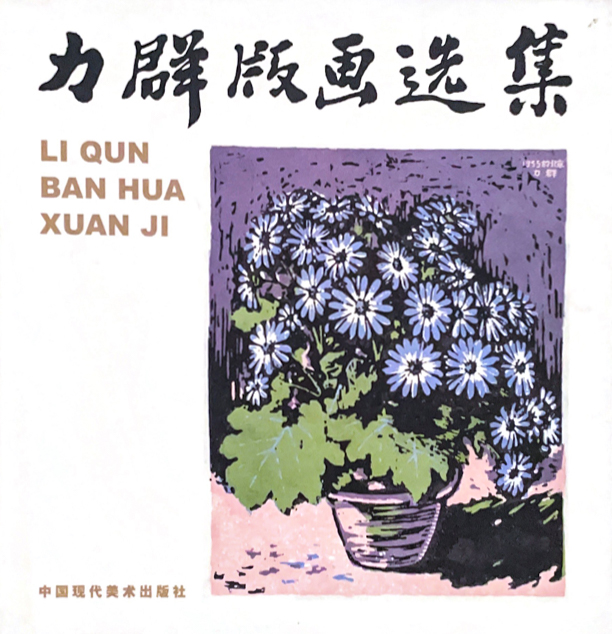
The text discusses an art exhibition held by Comrade Li Qun in Beijing’s Beihai Park, showcasing 26 pieces of his work, mostly new except for those from 1941. Despite facing challenges during various political movements over 39 years, Li Qun’s diligence shines through in his diverse and vibrant artworks. His
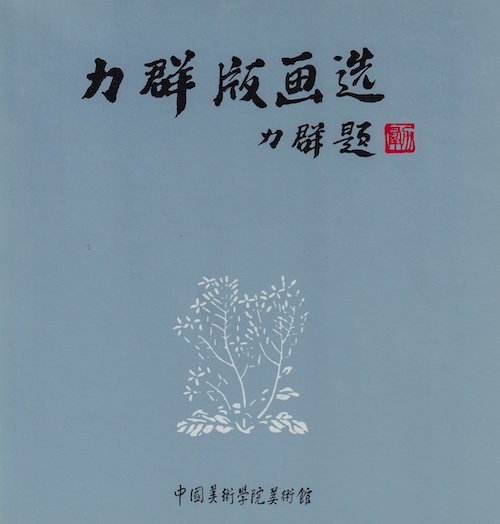
Li Qun, a native of Lingshi, Shanxi is a prominent figure in the realms of Chinese woodcuts and literary criticism. His artistic journey began at the National Hangzhou Art College (now the China Academy of Art) in 1931, a time when the influence of Lu Xun spurred a flourishing interest
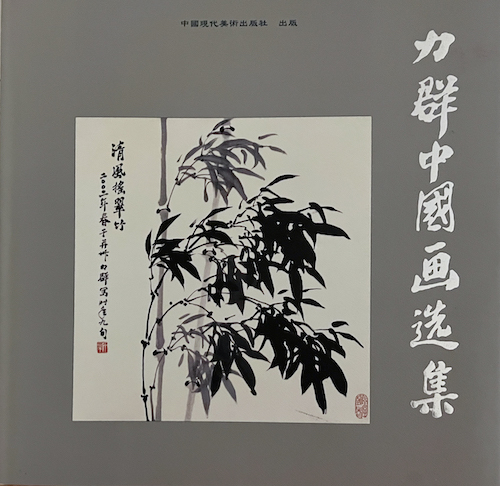
Li Qun, influenced by masters like Pan Tianshou and Li Kuchan, honed his Chinese painting skills at the National Hangzhou Art College. Combining this foundation with decades of printmaking experience, he crafts captivating works exhibited worldwide. His paintings, infused with spirit and form, resonate deeply, offering viewers a harmonious blend
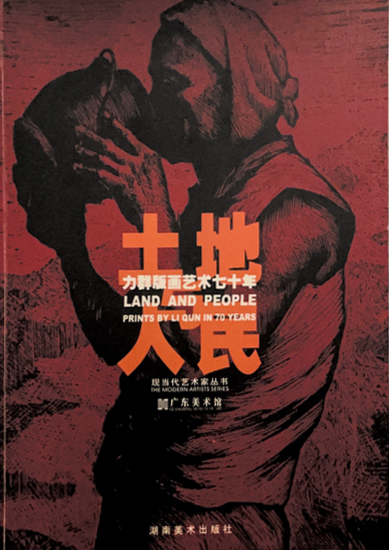
Li Qun emerges as a key figure, serving both as a witness and participant in the emerging art movement. Despite facing personal and societal challenges, Li Qun’s early works reflect influences from artists like Bouguereau and Mucha, as well as Soviet realism. Teaching at the Lu Xun Academy of Arts
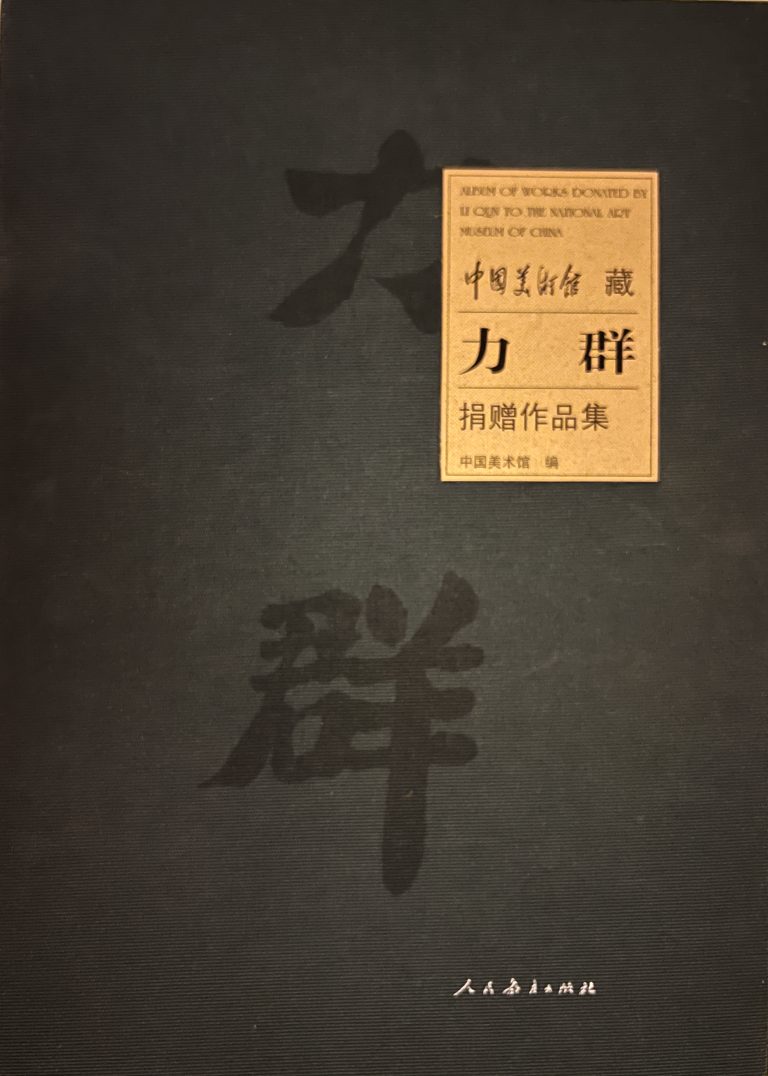
The “20th Century Special Incentive Scheme of National Art Collections and Donations” is a significant cultural initiative in China aimed at recognising artists’ contributions to 20th-century art. Started in 2004 under the Ministry of Culture’s leadership, it established the Shangguan Art Museum, praised by veteran artists who generously donated their
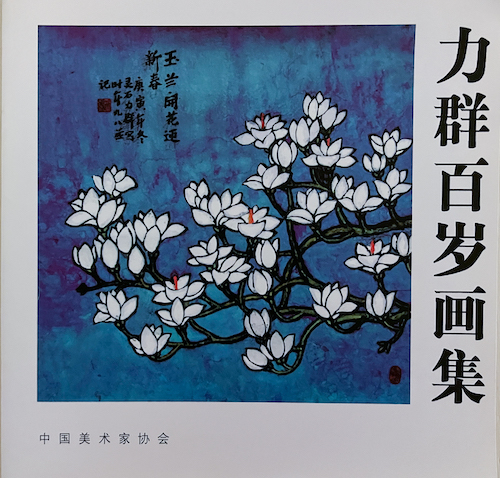
Titled “Li Qun’s 100-Year-Old Painting Collection,” this anthology celebrates the artist’s journey in Chinese painting, coinciding with his 99th birthday in December 2011. Tracing back to his education at the National Hangzhou Art College under revered mentors Pan Tianshou and Li Kutan, Li Qun initially pursued woodcarving. However, as age
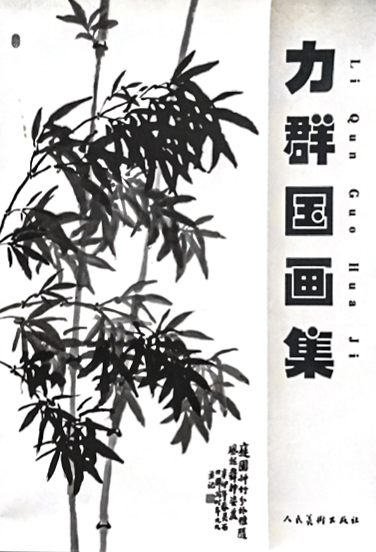
Mr. Li Qun, a respected figure in the Chinese art world, has been known nationwide for decades. Due to my love for art, I had the privilege of meeting him years ago. Despite the distance, our connection remained strong. In 2004, Mr. Li invited me to his solo exhibition, showcasing
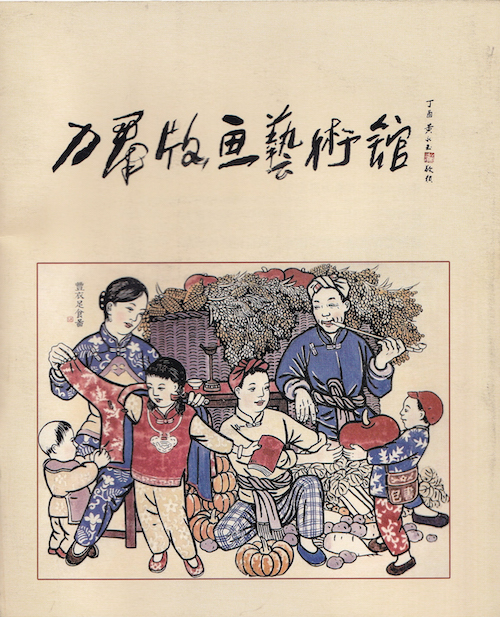
A collection of works donated to the Taiyuan Art Museum with the support of Li Qun’s family. The Li Qun Woodcuts Art Museum serves as a hub for collecting, preserving, and promoting his legacy. Located in Exhibition Hall 7 on the third floor of the Taiyuan Art Museum, the museum
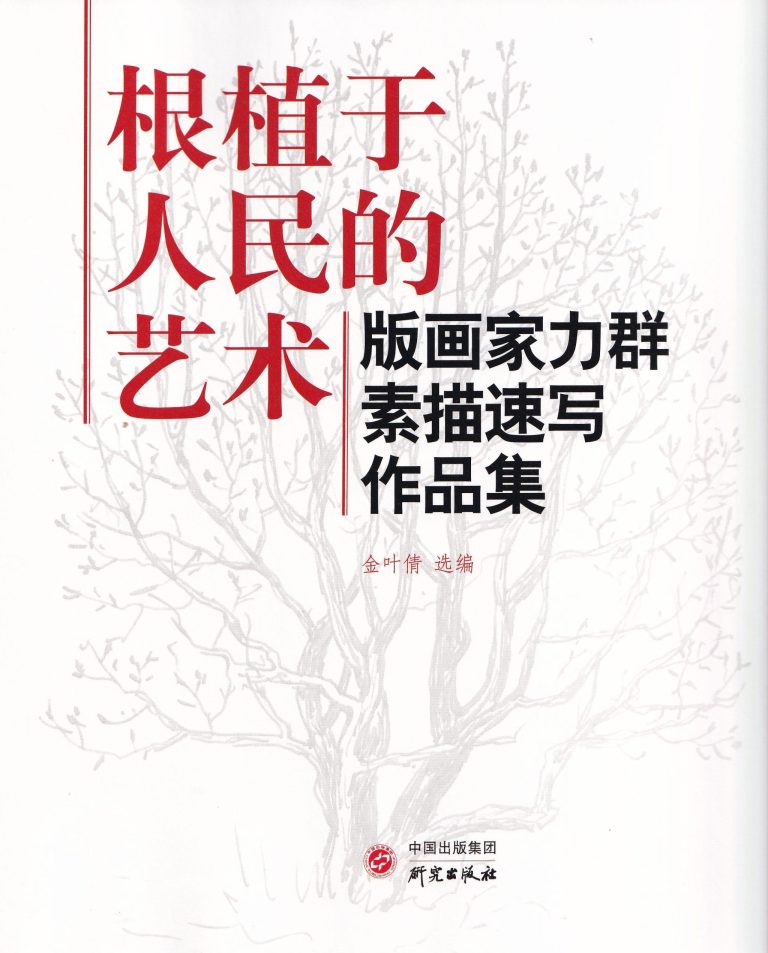
Mr. Li Qun, renowned for his woodcuts printmaking, left behind a collection of sketches that offer profound insights into his artistic journey. These sketches, discovered after his passing, span various subjects and scenes, reflecting the artist’s emotions and serving as source material. Despite their simplicity, they resonate deeply with viewers.
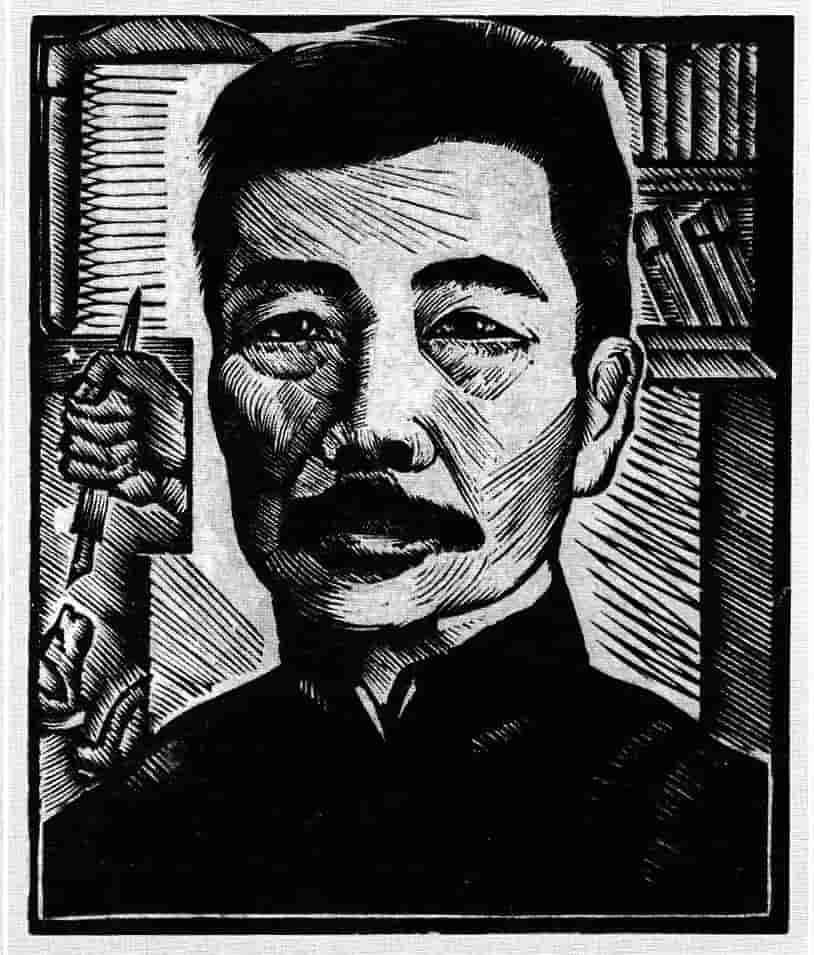
A comprehensive exploration of Li Qun Woodcuts spanning a remarkable 100-year chronicle that meticulously documents the life and career of this esteemed artist.
Gain insight into key events that shaped Li Qun’s trajectory, from his formative years in early 20th-century China to his influential presence in contemporary art. Discover the evolution of Li Qun’s craft as it intersects with major historical milestones, such as China’s Japanese invasion, Cultural Revolution and the modernisation era.
This chronicle provides a factual and detailed account of Li Qun’s journey, offering a unique lens into the socio-political landscape that has shaped both Li Qun and his iconic woodcut creations. Delve into the specifics of his chronicles to uncover the factual intricacies of a century-long artistic legacy.
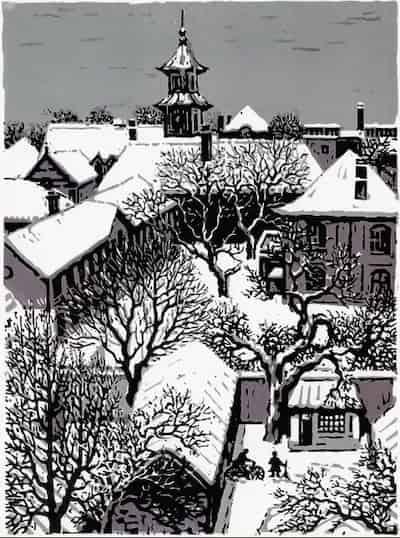
We offer a range of services from sourcing Li Qun’s art for purchase, but more importantly documenting artworks in public collections globally.
If you have Li Qun’s art work, we would like to keep a record of your collection. this is to help the future validations of Li Qun’s art work.
We are committed to facilitating a comprehensive understanding of Li Qun’s artistic legacy. While our services do not include artwork verification, we do have established contacts that may assist in this regard, subject to potential costs.
This website is managed by Li Qun’s family to preserve his legacy, and to connect with curators, historians, collectors, artists, fans and admires across the globe.
contact@liqunwoodcuts.org